Author Biographies 14
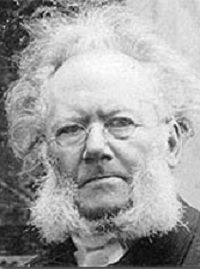 Henrik Ibsen
Henrik Ibsen
1828-1906
Born in 1828, Henrik Ibsen was a 19th century Norwegian playwright and theater director. He is often referred to as “the father” of modern theater.
He grew up in the small Norwegian coastal town of Skien as the oldest of five children born to Knud and Marichen Ibsen. At 15, Ibsen left school and went to work. He landed a position as an apprentice in an apothecary in Grimstad. He worked there for six years, using his limited free time to write poetry and to paint. In 1849, he wrote his first play, Catilina.
Ibsen moved to Christiania (later known as Oslo) in 1850 to prepare for university examinations to study at the University of Christiania. The following year, he had a fateful encounter with violinist and theater manager, Ole Bull. Bull liked Ibsen and offered him a job as a writer and manager for the Norwegian Theatre in Bergen. The position proved to be an intense tutorial in all things theatrical and even included traveling abroad to learn more about his craft. In 1857, Ibsen returned to Christiania to run another theater there. Despite difficulties, Ibsen found time to write Love’s Comedy, a satirical look at marriage, in 1862.
Ibsen left Norway in 1862, eventually settling in Italy for a time. There he wrote Brand, a five-act tragedy, in 1865. The play made him famous in Scandinavia. Two years later, Ibsen created one of his masterworks, Peer Gynt.
In 1868, Ibsen moved to Germany. During his time there, he saw his social drama, The Pillars of Society, first performed in Munich. The play helped launch his career and was soon followed up by one of his most famous works, A Doll’s House, in 1879. Around this time, he returned to Rome. His next work, Ghosts (1881), was followed by An Enemy of the People.
A few years later, Ibsen moved back to Germany, where he wrote one of his most famous works, Hedda Gabler (1890).
In 1891, Ibsen returned to Norway as a literary hero. He may have left as a frustrated artist, but he came back as an internationally known playwright. For much of his life, Ibsen had lived an almost reclusive existence. But he seemed to thrive in the spotlight in his later years, becoming a tourist attraction of sorts in Christiania. He also enjoyed the events held in his honor in 1898 to mark his 70th birthday.
The first play written after his return to Norway was The Master Builder. In When We Dead Awaken was written in 1899. It proved to be his final play.
In 1900, Ibsen had a series of strokes that left him unable to write. He died on May 23, 1906.
Source: http://www.biography.com/people/henrik-ibsen-37014
 Bibliography
Bibliography
Press your browser’s BACK button to return to the previous page.
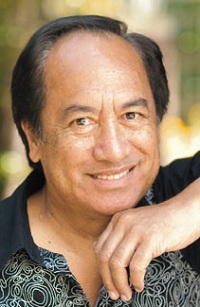 Witi Ihimaera
Witi Ihimaera
1944-
Witi Tame Ihimaera-Smiler (born February 7, 1944), generally known as Witi Ihimaera, is a New Zealand author and is often regarded as one of the most prominent Maori writers alive.
Ihimaera was born near Gisborne, a town in the east of New Zealand’s North Island, and is of Maori and Anglo-Saxon descent through his father, Tom. He attended Church College of New Zealand in Temple View, Hamilton, New Zealand. He was the first Maori writer to publish both a novel and a book of short stories.
He began to work as a diplomat at the New Zealand Ministry of Foreign Affairs in 1973 and served at various diplomatic posts in Canberra, New York and Washington, D.C. Ihimaera remained at the Ministry until 1989, although his time there was broken by several fellowships at the University of Otago in 1975 and Victoria University of Wellington in 1982, where he graduated with a B.A. In 1990, he took up a position at the University of Auckland, where he became Professor and Distinguished Creative Fellow in Maori Literature. He retired from this position in 2010.
Most of Ihimaera’s work consists of short stories or novels. He has written a considerable number of stories, with the most notable being works such as “Tangi, Pounamu, Pounamu” and “The Whale Rider.” His stories generally portray Maori culture in modern New Zealand. His work often focuses on problems within contemporary Maori society.
In 1995, Ihimaera published Nights in the Gardens of Spain, a semi-autobiographical work about a married father of two daughters “coming out” as gay. He had come out to himself in 1984 and began the work but, out of sensitivity to his daughters, did not finish or publish it then.
Source: http://en.wikipedia.org/wiki/Witi_Ihimaera
 Bibliography
Bibliography
Press your browser’s BACK button to return to the previous page.
 Immaculee Ilibagiza
Immaculee Ilibagiza
1972-
Immaculee Ilibagiza (born 1972) is a Rwandan author and motivational speaker. She is also a Roman Catholic and Tutsi. Her first book, Left to Tell: Discovering God Amidst the Rwandan Holocaust (2006), is an autobiographical work detailing how she survived during the Rwandan Genocide and how she felt when all of her family was killed by the Interhamwe soldiers who were Hutu.
Left to Tell recounts Ilibagiza’s experience during the 1994 Rwandan genocide. She survived hidden for 91 days with seven other women in a small bathroom, no larger than three feet long and four feet wide. The bathroom was concealed in a room behind a wardrobe in the home of a pastor. During the genocide, most of Ilibagiza’s family was killed: her mother, her father and her two brothers, Damascene and Vianney. Besides herself, the only other survivor in her family was her brother, Aimable, who was studying out of the country in Senegal at the time. With a lot of strength, she shares how her faith was what guided her in such a horrible experience.
Ilibagiza speaks all over the world and is the recipient of the 2007 Mahatma Gandhi Reconciliation and Peace Award. She has also written the book, Led by Faith.
Source: http://en.wikipedia.org/wiki/Immacul%C3%A9e_Ilibagiza
 Bibliography
Bibliography
Press your browser’s BACK button to return to the previous page.
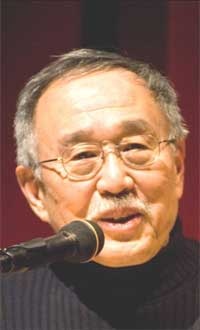 Lawson Fusao Inada
Lawson Fusao Inada
1938-
Lawson Fusao Inada (born 1938 in Fresno, California) is an American poet and was the fifth poet laureate of the State of Oregon.
Inada is a third-generation Japanese-American (Sansei). When he was four years old, Inada and his family were interned for the duration of World War II at camps in Fresno, Arkansas and Colorado.
Following the war, Inada became a jazz musician, a bassist, following the work of Miles Davis, John Coltrane and Billie Holiday, to whom he would later write tributes in his works. Inada cites jazz and his time in the internment camps as his chief influences as a poet. He studied writing at the University of California, Berkeley, the University of Oregon and the University of Iowa. He began teaching poetry at Southern Oregon University in 1966.
In 1994, Inada’s Legends from Camp won an American Book Award and he has received several poetry fellowships from the National Endowment for the Arts. He also won the 1997 Stafford/Hall Award for Poetry.
In 2006, Inada was named Oregon’s fifth poet laureate, the first person to fill the position since William Stafford in 1989. He was succeeded by Paulann Petersen in 2010.
Source: http://en.wikipedia.org/wiki/Lawson_Fusao_Inada
 Bibliography
Bibliography
Press your browser’s BACK button to return to the previous page.
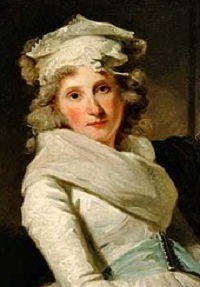 Elizabeth Inchbald
Elizabeth Inchbald
1753-1821
Elizabeth Inchbald (nee Simpson) (October 15, 1753-August 1, 1821) was an English novelist, actress and dramatist. Born at Standingfield, near Bury St. Edmunds, Suffolk, Elizabeth was the eighth of the nine children of John Simpson (died 1761), a farmer, and his wife Mary, nee Rushbrook.
At the age of 19, she went to London to pursue a career as an actress. In 1772, she agreed to marry a fellow Catholic, the actor Joseph Inchbald (1735-1779), possibly at least partially for protection. The marriage was reported to have had difficulties. For four years, the couple toured Scotland with West Digges’ theatre company, a demanding life. In 1776, they moved to Liverpool. The Inchbalds subsequently moved to Canterbury and Yorkshire. After her husband’s death in 1779, Inchbald continued to act for several years in Dublin, London and elsewhere. Her acting career, while only moderately successful, spanned 17 years and she appeared in many classical roles, as well as in new plays, such as Hannah Cowley’s The Belle’s Stratagem.
Between 1784 and 1805, Inchbald had 19 of her comedies, sentimental dramas and farces (many of which were translations from the French) performed at London theatres. Eighteen of her plays were published, though she wrote several more; the exact number is in dispute, though most recent commentators claim between 21 and 23. Her two novels have been frequently reprinted. She also did considerable editorial and critical work. A four-volume autobiography was destroyed before her death upon the advice of her confessor, but she left some of her diaries.
She died on August 1, 1821 in Kensington.
Source: http://en.wikipedia.org/wiki/Elizabeth_Inchbald
 Bibliography
Bibliography
Press your browser’s BACK button to return to the previous page.
 William Inge
William Inge
1913-1973
William Motter Inge was born at Independence, Kansas, on May 3, 1913. At the age of 17, in 1930, Inge went to the University of Kansas, Lawrence, where he graduated in 1935. He spent longer than the usual four years there because he took off one year to travel with a tent theater company. From U.K., Inge went to the George Peabody Teacher’s College in Nashville, Tennessee, where he had a scholarship. He soon dropped out of Peabody and returned to Kansas, odd-jobbing as a laborer with a highway gang, as an announcer for a Wichita radio station and as a radio writer.
In 1937, he taught high school at Columbus, Kansas, and then returned in 1938 to Peabody to complete his M.A. From his graduation until 1943, Inge taught at Stephens College in Columbia, Missouri. He was becoming more involved with the theatre (he was drama critic for The St. Louis Star-Times from 1943-1946) when he took another teaching post, this time at Washington College in St. Louis. During his stay in St. Louis, he saw Tennessee Williams’ The Glass Menagerie and decided that he should write plays himself. He met Williams and found encouragement.
Inge’s first plays, written in the mid-1940s, were performed by a little theater in Dallas, Texas. His first hit play was Come Back, Little Sheba. Performed on Broadway in 1950, it won the George Nathan Award and the Theater Time Award. It was followed by Picnic (1953), which won the Pulitzer Prize, the Drama Critics Award and the Outer Circle Award. Bus Stop, in 1955, was another big success, as was The Dark at the Top of the Stairs, which opened on Broadway in 1957. Originally titled Farther Off from Heaven, the play is dedicated to Tennessee Williams.
His 1959 play, A Loss of Roses, was not well received and it started a downhill slide for Inge that was relieved only by his winning the Academy Award for the original story and screenplay of Splendor in the Grass in 1961. After a series of his plays were panned by the critics, Inge began teaching again. He also explored the novel, writing My Son Is a Splendid Driver (1971) and Good Luck, Miss Wyckoff (1970).
In 1973, reportedly discouraged and depressed, Inge committed suicide on June 10, at Irvine, California.
Source: http://www.washburn.edu/reference/cks/mapping/inge/index.html
 Bibliography
Bibliography
Press your browser’s BACK button to return to the previous page.
 Eugene Ionesco
Eugene Ionesco
1909-1994
Eugene Ionesco (November 26, 1909-March 28, 1994) was a Romanian and French playwright and dramatist, one of the foremost playwrights of the Theatre of the Absurd. Beyond ridiculing the most banal situations, Ionesco’s plays depict in a tangible way the solitude and insignificance of human existence.
Ionesco was born in Slatina, Romania, to a Romanian father of the Orthodox religion and a mother of French and Greek-Romanian heritage, whose religion was Protestant. He was baptized into the Romanian Orthodox religion.
He spent most of his childhood in France, returning to Romania with his father and mother in 1925 after his parents divorced. There he attended Saint Sava National College, after which he studied French Literature at the University of Bucharest from 1928 to 1933 and qualified as a teacher of French.
He returned to France in 1938 to complete his doctoral thesis. Caught by the outbreak of World War II in 1939, he returned to Romania but soon changed his mind and, with the help of friends, obtained travel documents that allowed him to return to France in 1942, where he remained during the rest of the war, living in Marseille before moving with his family to Paris after its liberation.
Eugene Ionesco died at age 84 on March 28, 1994.
Source: http://en.wikipedia.org/wiki/Eug%C3%A8ne_Ionesco
 Bibliography
Bibliography
Press your browser’s BACK button to return to the previous page.
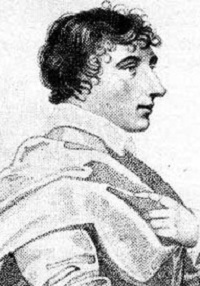 William Henry Ireland
William Henry Ireland
1775-1835
William Henry Ireland (August 2, 1775-April 17, 1835) was an English forger of would-be Shakespearean documents and plays. He is less well-known as a poet, writer of gothic novels and histories.
Although Ireland claimed throughout his life that he was born in London in 1777, recently discovered evidence puts his birth two years earlier, on August 2, 1775. His father, Samuel Ireland, was a successful publisher of travelogues, collector of antiquities and collector of Shakespearian plays and “relics.” There was at the time, and still is, a great paucity of writing in the hand of Shakespeare. Of his 37 plays, there is not one copy in his own writing, not a scrap of correspondence from Shakespeare to a friend, fellow writer, patron, producer or publisher. Forgery would fill this void.
In December 1794, Ireland told his father that he had discovered a cache of old documents belonging to an acquaintance who wanted to remain unnamed and that one of them was a deed with a signature of Shakespeare in it. He gave the document – which he had, of course, made himself – to his overjoyed father, who had been looking for just that kind of signature for years.
Ireland went on to make more findings – a promissory note, a written declaration of Protestant faith, letters to Anne Hathaway (with a lock of hair attached) and to Queen Elizabeth – all supposedly in Shakespeare’s hand. He claimed that all came from the chest of the anonymous friend. He “found” books with Shakespeare’s notes in the margins and “original” manuscripts for Hamlet and King Lear. The supposed experts of the day authenticated them all.
On December 24, 1795, Samuel Ireland published his own book about the papers, a lavishly illustrated and expensively produced set of facsimiles and transcriptions of the papers called Miscellaneous Papers and Legal Instruments under the Hand and Seal of William Shakespeare (the book bears the publication date 1796). More people took interest in the matter and the plot began to unravel.
In 1795, Ireland became bolder and produced a whole new play – Vortigern and Rowena. After extensive negotiations, Irish playwright Richard Brinsley Sheridan acquired rights for the first production of the play at London’s Drury Lane Theatre for 300 pounds and a promise of half of all profits to the Irelands. Sheridan read the play and noticed it was relatively simplistic compared to Shakespeare’s “other” works. John Philip Kemble, actor and manager of Drury Lane Theatre, later claimed he had serious doubts about its authenticity; he also suggested that the play appear on April Fool’s Day, though Samuel Ireland objected, and the play was moved to the next day.
When critics closed in and accused Samuel Ireland of forgery, his son published a confession – “An Authentic Account of the Shaksperian Manuscripts” – but many critics could not believe a young man could have forged them all by himself. In 1805, Ireland published “The Confessions of William Henry Ireland,” but confession did not help his reputation.
Source: http://en.wikipedia.org/wiki/William_Henry_Ireland
 Bibliography
Bibliography
Press your browser’s BACK button to return to the previous page.
 John Irving
John Irving
1942-
John Winslow Irving (born John Wallace Blunt Jr.; March 2, 1942) is an American novelist and Academy Award-winning screenwriter.
Irving’s career began at the age of 26 with the publication of his first novel, Setting Free the Bears. His second and third novels, The Water-Method Man and The 158-Pound Marriage, were well received. At around this time, in 1975, Irving accepted a position as Assistant Professor of English at Mount Holyoke College.
Irving published his fourth novel, The World According to Garp, in 1978. Garp transformed Irving from an obscure, academic literary writer to a household name and his subsequent books were bestsellers. The next was The Hotel New Hampshire (1981). In 1985, Irving published The Cider House Rules. A Son of the Circus was published in 1995, A Widow for One Year in 1998 and The Fourth Hand in 2001.
In 1999, Irving wrote My Movie Business, a memoir about his involvement in creating the film version of The Cider House Rules.
A Sound Like Someone Trying Not to Make a Sound, a children’s story originally included in A Widow for One Year, was published as a book with illustrations by Tatjana Hauptmann in 2004. Irving’s novel, Until I Find You, was released on July 12, 2005.
His most recent novel, Last Night in Twisted River, was published in 2009.
Source: http://en.wikipedia.org/wiki/John_Irving
 Bibliography
Bibliography
Press your browser’s BACK button to return to the previous page.
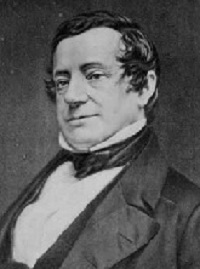 Washington Irving
Washington Irving
1783-1859
Washington Irving (April 3, 1783-November 28, 1859) was an American author, essayist, biographer and historian of the early 19th century. He is best known for his short stories, “The Legend of Sleepy Hollow” and “Rip Van Winkle,” both of which appear in his book, The Sketch Book of Geoffrey Crayon, Gent. His historical works include biographies of George Washington, Oliver Goldsmith and Muhammad, and several histories of 15th century Spain dealing with subjects such as Christopher Columbus, the Moors and the Alhambra. Irving also served as the U.S. minister to Spain from 1842 to 1846.
He made his literary debut in 1802 with a series of observational letters to The Morning Chronicle, written under the pseudonym Jonathan Oldstyle. After moving to England for the family business in 1815, he achieved international fame with the publication of The Sketch Book of Geoffrey Crayon, Gent. in 1819. He continued to publish regularly – and almost always successfully – throughout his life and completed a five-volume biography of George Washington just eight months before his death, at age 76, in Tarrytown, New York.
Irving, along with James Fenimore Cooper, was among the first American writers to earn acclaim in Europe. Irving encouraged American authors such as Nathaniel Hawthorne, Herman Melville, Henry Wadsworth Longfellow and Edgar Allan Poe. As America’s first genuine internationally bestselling author, Irving advocated for writing as a legitimate profession and argued for stronger laws to protect American writers from copyright infringement.
Source: http://en.wikipedia.org/wiki/Washington_Irving
 Bibliography
Bibliography
Press your browser’s BACK button to return to the previous page.
 Dave Isay
Dave Isay
1966-
David Isay is the founder of StoryCorps. His radio documentary work has won nearly every award in broadcasting, including five Peabody Awards. He has also received a Guggenheim Fellowship, a MacArthur Fellowship and a United States Artists Fellowship.
Source: http://search.barnesandnoble.com/Listening-Is-an-Act-of-Love/Dave-Isay/e/9780143114345
 Bibliography
Bibliography
Press your browser’s BACK button to return to the previous page.
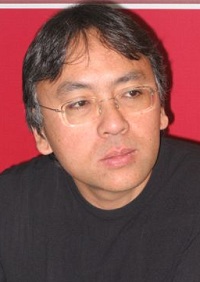 Kazuo Ishiguro
Kazuo Ishiguro
1954-
Kazuo Ishiguro (born November 8, 1954) is a Japanese-British novelist born in Nagasaki, Japan. He is the son of Shizuo Ishiguro, a physical oceanographer, and his wife, Shizuko. In 1960, his family, including his two sisters, moved to Guildford, Surrey, so that his father could work on oil development in the North Sea.
He attended Stoughton Primary School and then Woking County Grammar School in Surrey. After finishing school, he took a “gap year” and traveled through America and Canada while writing a journal and sending demo tapes to record companies. Ishiguro obtained his bachelor’s degree from the University of Kent in 1978 and his master’s from the University of East Anglia’s creative writing course in 1980. He became a British citizen in 1982.
Ishiguro is one of the most celebrated contemporary fiction authors in the English-speaking world, having received four Man Booker Prize nominations and winning the 1989 prize for his novel, The Remains of the Day. Recently, his novel, Never Let Me Go, has been adapted to film.
He co-wrote four of the songs on jazz singer Stacey Kent’s 2009 Breakfast On the Morning Tram album. He also wrote the liner notes to Kent’s 2003 album, In Love Again.
Source: http://en.wikipedia.org/wiki/Kazuo_Ishiguro
 Bibliography
Bibliography
Press your browser’s BACK button to return to the previous page.
 Helen Hunt Jackson
Helen Hunt Jackson
1830-1885
Helen Maria Hunt Jackson (October 18, 1830-August 12, 1885) was an American writer who became an activist on behalf of improved treatment of Native Americans by the U.S. government. She detailed the adverse effects of government actions in A Century of Dishonor (1881). Her novel, Ramona, dramatized the federal government’s mistreatment of Native Americans in Southern California and attracted considerable attention to her cause, although its popularity was based on its romantic and picturesque qualities rather than its political content.
Jackson was born Helen Fiske in Amherst, Massachusetts, daughter of Nathan Welby Fiske and Deborah Waterman Vinal. Her father was a minister, author and professor of Latin, Greek and philosophy at Amherst College. Jackson’s mother died in 1844 when she was 14; her father died three years later. Her father provided for her education and arranged for an aunt to care for her. Jackson attended Ipswich Female Seminary and the Abbott Institute, a boarding school. In 1852, at age 22, Jackson married U.S. Army Captain Edward Bissell Hunt.
Jackson began writing after the deaths of her family members. She published her early work anonymously, usually under the name “H.H.,” and traveled widely. In the winter of 1873-1874, she was in Colorado Springs, Colorado, in search of a cure for tuberculosis. Over the next two years, she published three novels in the anonymous No Name series, including Mercy Philbrick’s Choice and Hetty’s Strange History.
In 1879, her interests turned to Native Americans after hearing a lecture in Boston by Ponca Chief Standing Bear. He described the forcible removal of the Ponca from their Nebraska reservation. Upset about the mistreatment of Native Americans by government agents, Jackson became an activist. She started investigating and publicizing government misconduct, circulating petitions, raising money and writing letters to The New York Times on behalf of the Ponca. She won the support of several newspaper editors who published her reports. Jackson also wrote a book, the first work she published under her own name, condemning state and federal Indian policy and detailing the history of broken treaties. A Century of Dishonor (1882) called for significant reform in government policy toward Native Americans.
Jackson decided to write a novel to reach a wider audience than she had with her historical work. Although she started an outline in California, she began writing the novel in December 1883 in her New York hotel room and completed it in about three months. Originally titled In The Name of the Law, she published it as Ramona (1884). Encouraged by the popularity of her book, Jackson planned to write a children’s story about Indian issues but did not live to complete it.
Jackson died of stomach cancer in 1885 in San Francisco, California.
Source: http://en.wikipedia.org/wiki/Helen_Hunt_Jackson
 Bibliography
Bibliography
Press your browser’s BACK button to return to the previous page.
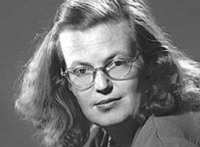 Shirley Jackson
Shirley Jackson
1916-1965
Shirley Jackson (December 14, 1916-August 8, 1965) was an American author. A popular writer in her time, her work has received increasing attention from literary critics in recent years.
She is best known for the short story, “The Lottery” (1948), which suggests a secret, sinister underside to bucolic small-town America. In her critical biography of Jackson, Lenemaja Friedman notes that when “The Lottery” was published in the June 26, 1948, issue of The New Yorker, it received a response that “no New Yorker story had ever received.” Hundreds of letters poured in that were characterized by, as Jackson put it, “bewilderment, speculation and old-fashioned abuse.”
In addition to her adult literary novels, Jackson also wrote a children’s novel, Nine Magic Wishes, available in an edition illustrated by her grandson, Miles Hyman, as well as a children’s play based on Hansel and Gretl and entitled The Bad Children. In a series of short stories, later collected in the books Life among the Savages and Raising Demons, she presented a fictionalized version of her marriage and the experience of bringing up four children. These stories pioneered the “true-to-life funny-housewife stories” of the type later popularized by such writers as Jean Kerr and Erma Bombeck during the 1950s and 1960s.
In 1965, Shirley Jackson died of heart failure in her sleep, at the age of 48, at her home in North Bennington, Vermont.
Source: http://en.wikipedia.org/wiki/Shirley_Jackson
 Bibliography
Bibliography
Press your browser’s BACK button to return to the previous page.
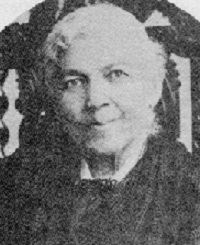 Harriet Jacobs
Harriet Jacobs
1813-1897
Writer, abolitionist and reformer Harriet Jacobs was born a slave in Edenton, North Carolina, the daughter of two slaves owned by different masters. The story of her life, Incidents in the Life of a Slave Girl, Written by Herself, published under the pseudonym Linda Brent in 1861, helped build Northern sentiment for emancipation during the Civil War and was probably the only slave narrative to deal with sexual oppression as well as oppression of race and condition.
During her childhood in Edenton, young Harriet lived with her mother as part of a close-knit family. When Harriet’s mother died in 1819, the six-year-old girl was taken into the home of her mistress, Margaret Horniblow, who taught her how to read and write. Harriet was very fond of Miss Horniblow and expected to be emancipated. Instead, when Miss Horniblow died in 1825, she willed Harriet to her three-year-old niece, Mary Matilda Norcom. Within two years of moving into the Norcom home, Harriet found herself the object of Dr. Norcom’s unwanted sexual advances and Mrs. Norcom’s vindictive jealousy. In 1829, she began a liaison with Samuel Treadwell Sawyer. The couple had a son, Joseph, in 1829, and a daughter, Louisa Matilda, in 1833. In retaliation, Norcom sent Harriet to one of his plantations to be broken in as a field hand. Before her children could be sent to join her, Harriet ran away and went into hiding at her grandmother’s house. Her maternal grandmother, Molly Horniblow, had been emancipated during the American Revolution, sold back into slavery as a prize of war and was re-emancipated in 1828. Harriet hid for six years and 11 months in a space under the front porch roof of Molly Horniblow’s house.
In 1842, Harriet Jacobs escaped from Edenton by boat, traveling eventually to New York, where she went to work as a nursemaid for the family of abolitionist Nathaniel Parker Willis. For the next few years, she traveled between New York and Boston, eventually reuniting with her children. During this period, she became active in a circle of anti-slavery feminists and met Amy Post who, along with Mary Willis, would eventually encourage her to write the story of her life. In order to subvert the continued efforts of Jacobs’ former owners to re-enslave her, the Willises eventually bought Harriet and freed her in 1852.
The next year, she began work on Incidents in the Life of a Slave Girl. Her first two attempts to publish the book came to nothing when both publishing houses that accepted the manuscript went bankrupt. She finally purchased the plates of her book and had it published by a Boston printer “for the author” in 1861. The book contained a preface written by Lydia Maria Child, an abolitionist writer. The British edition, The Deeper Wrong, was published in 1862.
Through the war years, Harriet Jacobs lived in Washington, D.C., assisting contrabands, nursing black troops and teaching. After the war, she and her daughter did relief work in Savannah and Edenton. In 1868, they traveled to London to raise funds for an orphanage and home for the aged in Savannah. The year before her death in 1897, she was actively involved in organizing meetings of the National Association of Colored Women in Washington, D.C. She is buried in Mount Auburn Cemetery, Cambridge, Massachusetts.
Source: http://www.ncwriters.org/services/lhof/inductees/hjacobs.htm
 Bibliography
Bibliography
Press your browser’s BACK button to return to the previous page.
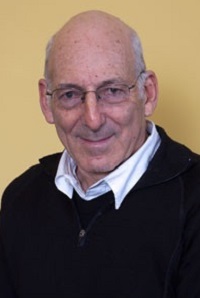 Russell Jacoby
Russell Jacoby
1945-
Russell Jacoby (born April 23, 1945) is a professor of history at the University of California, Los Angeles (UCLA), an author and critic of academic culture. His fields of interest are 20th century European and American intellectual and cultural history, specifically the history of intellectuals and education. In 2009, he was appointed to the Moishe Gonzales Folding Chair of Critical Theory.
He was born in New York City and educated at the University of Chicago and University of Wisconsin-Madison. Jacoby received his Ph.D in 1974 from the University of Rochester.
Source: http://en.wikipedia.org/wiki/Russell_Jacoby
 Bibliography
Bibliography
Press your browser’s BACK button to return to the previous page.
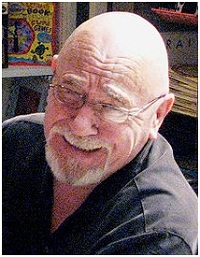 Brian Jacques
Brian Jacques
1939-2011
James Brian Jacques (pronounced “Jakes;” June 15, 1939-February 5, 2011) was an English author best known for his Redwall series of novels and Castaways of the Flying Dutchman series. He also completed two collections of short stories: The Ribbajack & Other Curious Yarns and Seven Strange and Ghostly Tales.
Jacques was born in Liverpool, England. His parents were James Alfred Jacques, a Haulage Contractor, and Ellen Ryan. He grew up in Kirkdale near the Liverpool Docks.
Jacques showed early writing talent. At age 10, assigned to write an animal story, he wrote about a bird that cleaned a crocodile’s teeth. His teacher could not believe a 10-year-old wrote it and caned the boy for refusing to admit copying the story. He had always loved to write, but only then did he realize the extent of his abilities.
He attended St. John’s school until age 15, when he left (as was usual at the time) and set out to find adventure as a merchant sailor. His book, Redwall, was written for his “special friends,” the children of the Royal Wavertree School for the Blind, whom he first met while delivering milk. He began to spend time with the children and eventually started writing stories for them. This accounts for the very descriptive style of the novel and the ones to follow.
Jacques was admitted to the Royal Liverpool Hospital to undergo emergency surgery for an aortic aneurysm. Despite the efforts to save him, he died from a heart attack on February 5, 2011.
Source: http://en.wikipedia.org/wiki/Brian_Jacques
 Bibliography
Bibliography
Press your browser’s BACK button to return to the previous page.
 King James VI & I
King James VI & I
1566-1625
James I of England and VI of Scotland was born in 1566, the son of Mary, Queen of Scots, and Henry, Lord Darnley. James grew up under various regencies and a couple of notable tutors: The poet, dramatist and humanist George Buchanan, and Peter Young, whose good nature and enthusiasm for lighter reading somewhat offset the formidable learning and sometimes overbearingly serious teaching methods of Buchanan. From Young he learned to appreciate poetry and delved deeply into his mother’s library of French verse and romances. James developed a genuine love of learning, some skill in writing poetry and a lively prose style. He also showed an interest in plays, including those of Shakespeare and Jonson, and was particularly fond of the masque, which would become the leading form of court entertainment when he became King of England in 1603.
James published his first book in 1584, entitled The Essays of a Prentice in the Divine Art of Poesy, which he followed up in 1591 with His Majesties Poetical Exercises at Vacant Hours. As a King, James had a special relationship with God and could therefore write religious poetry from a special viewpoint. James’ poetry is competent and sometimes he manages a striking line or two; one of his best poems is the sonnet he wrote prefacing his book, Basilikon Doron (1599).
The majority of James’ written works are concerned with theology and the justification of the theory of Divine Right; for those reasons, he must be considered as a major writer of political philosophy. In lively style and with considerable learning, he defended the Oath of Allegiance that Catholics were required to take, disputed it with the great Cardinal Bellarmine, wrote two books on Divine Right – one, Basilikon Doron, for the edification of his son Prince Henry (1594-1612) and the other, The True Law of Free Monarchies, was a simple explanation of his theories for the general literate public. James also wrote some rather moving “Meditations on the Lord’s Prayer” and a justly famous essay, “A Counterblast to Tobacco” (1604), one of the first, and surely one of the best attacks on smoking ever written.
James I’s impact on English literature is considerable, not least because of his encouragement of and participation in the translation of the Bible into English (1611), the translation that many people still consider the best and which bears his name, the King James Bible.
He died at Theobalds House on March 27, 1625.
Source: http://www.luminarium.org/sevenlit/james/jamesbio.htm
 Bibliography
Bibliography
Press your browser’s BACK button to return to the previous page.
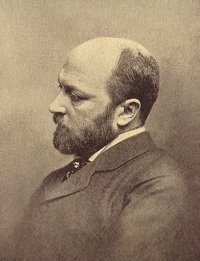 Henry James
Henry James
1843-1916
Henry James, OM (April 15, 1843-February 28, 1916) was an American-born writer, regarded as one of the key figures of 19th century literary realism.
James was born in New York City into a wealthy family. His father, Henry James Sr., was one of the best-known intellectuals in mid-19th century America. In his youth, James traveled back and forth between Europe and America. He studied with tutors in Geneva, London, Paris, Bologna and Bonn. At the age of 19, he briefly attended Harvard Law School but preferred reading literature to studying law. James published his first short story, “A Tragedy of Error,” at age 21, and devoted himself to literature. In 1866-69 and 1871-72, he was a contributor to The Nation and Atlantic Monthly.
From an early age, James read the classics of English, American, French and German literature, as well as Russian classics in translation. His first novel, Watch and Ward (1871), was written while traveling through Venice and Paris. After living in Paris, where he was contributor to The New York Tribune, James moved to England in 1876, living first in London and then in Rye, Sussex. During his first years in Europe, James wrote novels that portrayed Americans living abroad. In 1905, James visited America for the first time in 25 years and wrote “Jolly Corner.”
Among James’ masterpieces are: Daisy Miller (1879), in which the eponymous protagonist, the young and innocent American Daisy Miller, finds her values in conflict with European sophistication; and The Portrait of a Lady (1881), in which a young American woman finds that her upbringing has ill prepared her against two scheming American expatriates during her travels in Europe. The Bostonians (1886) is set in the era of the rising feminist movement. What Maisie Knew (1897) depicts a preadolescent girl who must choose between her parents and a motherly old governess. In The Wings of the Dove (1902), an inheritance destroys the love of a young couple. James considered The Ambassadors (1903) his most “perfect” work of art. James’ most famous novella is The Turn of the Screw, a ghost story in which the question of childhood corruption obsesses a governess. Although James is best known for his novels, his essays are now attracting a more general audience.
Between 1906 and 1910, James revised many of his tales and novels for the New York edition of his complete works. His autobiography, A Small Boy and Others, appeared in 1913 and was continued in Notes of a Son and Brother (1914). The third volume, The Middle Years, appeared posthumously in 1917. The outbreak of World War I was a shock for James and, on July 26, 1915, he became a British citizen as a declaration of loyalty to his adopted country and in protest against America’s refusal to enter the war. James suffered a stroke on December 2, 1915, and died in London on February 28, 1916. He was cremated at Golders Green Crematorium and his ashes are interred at Cambridge, Massachusetts.
Source: http://en.wikipedia.org/wiki/Henry_James
 Bibliography
Bibliography
Press your browser’s BACK button to return to the previous page.
 P.D. James
P.D. James
1920-2014
Phyllis Dorothy James, Baroness James of Holland Park (August 3, 1920-November 27, 2014), commonly known as P.D. James, was an English crime writer and Conservative life peer in the House of Lords, most famous for a series of detective novels starring policeman and poet, Adam Dalgliesh.
James was born in Oxford, the daughter of Sidney James, a tax inspector, and educated at the British School in Ludlow and Cambridge High School for Girls. She had to leave school at age 16 to work: Her family did not have much money and her father did not believe in higher education for girls. James worked in a tax office for three years and later found a job as an assistant stage manager for a theater group. After World War II, she studied hospital administration (management) and, from 1949 to 1968, worked for a hospital board in London, England.
James began writing in the mid-1950s. Her first novel, Cover Her Face, was published in 1962.
She worked in government service until her retirement in 1979. She was an Anglican and a Lay Patron of the Prayer Book Society. Her 2001 work, Death in Holy Orders, displays her familiarity with the inner workings of church hierarchy. Her later novels are often set in a community closed in some way, such as a publishing house or barristers’ chambers, a theological college, an island or a private clinic. The Adam Dalgliesh novel, The Private Patient, was published in August 2008 in the U.K. Talking about Detective Fiction was published in 2009. Over her writing career, James also wrote many essays and short stories for periodicals and anthologies. She revealed in 2011 that The Private Patient was the final Dalgliesh novel.
In 2008, she was inducted into the International Crime Writing Hall of Fame at the inaugural ITV3 Crime Thriller Awards.
James died at her home in Oxford on 27 November 2014, aged 94.
Source: http://en.wikipedia.org/wiki/P._D._James
 Bibliography
Bibliography
Press your browser’s BACK button to return to the previous page.
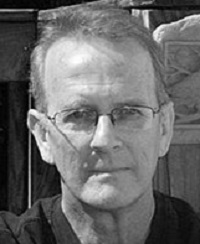 Mark Jarman
Mark Jarman
1952-
Mark F. Jarman (born June 5, 1952, in Mount Sterling, Kentucky) is an American poet and critic often identified with the New Narrative branch of the New Formalism; he was co-editor with Robert McDowell of The Reaper throughout the 1980s. Centennial Professor of English at Vanderbilt University, he is the author of 10 books of poetry, two books of essays and a book of essays co-authored with Robert McDowell. He co-edited the anthology, Rebel Angels: 25 Poets of the New Formalism, with David Mason.
Jarman was born while his father, Dr. Donald R. Jarman, was in seminary in Lexington, Kentucky. His parents, both Californians, moved back to California in 1954 and settled in Santa Maria, where his father served as pastor of the First Christian Church. In 1958, responding to a call from his denomination, Rev. Jarman moved his wife, Bo Dee, his son and daughter, Katie, to Scotland to serve a small church in Kirkcaldy, Fife, a linoleum factory town on the Firth of Forth across from Edinburgh. The three years he spent there were formative ones for the poet. The family returned to California in 1961, where his father served South Bay Christian Church in Redondo Beach and his sister, Luanne, was born. In 1970, Jarman entered the University of California at Santa Cruz and earned a B.A. with highest honors in English literature in 1974.
In 1974, Jarman entered the Iowa Writers’ Workshop and earned an M.F.A. in poetry in 1976. Also in 1976, he was hired to teach creative writing at Indiana State University in Evansville. In 1978, a grant from the National Endowment for the Arts allowed him to quit his job and live in Italy. Returning to California in 1979, he was hired as a visiting writer at the University of California at Irvine. In 1980, Jarman took a position teaching creative writing at Murray State University in Kentucky. In 1983, he left Murray State to teach at Vanderbilt University, where he continues working. Since 2007, Jarman has been Centennial Professor of English at Vanderbilt and Director of Creative Writing.
Source: http://en.wikipedia.org/wiki/Mark_Jarman
 Bibliography
Bibliography
Press your browser’s BACK button to return to the previous page.
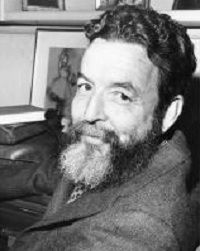 Randall Jarrell
Randall Jarrell
1914-1965
In 1914, Randall Jarrell was born in Nashville, Tennessee. He earned bachelor’s and master’s degrees from Vanderbilt University. From 1937 to 1939, he taught at Kenyon College, where he met John Crowe Ransom and Robert Lowell, and then at the University of Texas.
His first book of poems, Blood for a Stranger, was published in 1942, the same year he enlisted in the U.S. Army Air Corps. He soon left the Air Corps for the Army and worked as a control tower operator, an experience that provided much material for his poetry.
Jarrell’s reputation as a poet was established in 1945, while he was still serving in the Army, with the publication of his second book, Little Friend, Little Friend, which bitterly and dramatically documents the intense fears and moral struggles of young soldiers. Other volumes followed, all characterized by great technical skill, empathy with the lives of others and an almost painful sensitivity.
Following the war, Jarrell accepted a teaching position at the Woman’s College of the University of North Carolina, Greensboro, and remained there, except for occasional absences to teach elsewhere, until his death. Even more than for his poems, Jarrell is highly regarded as a peerless literary essayist and was considered the most astute (and most feared) poetry critic of his generation.
Jarrell was struck by a car and killed at the age of 51 in 1965, a death that may or may not have been a suicide.
Source: http://www.poets.org/poet.php/prmPID/9
 Bibliography
Bibliography
Press your browser’s BACK button to return to the previous page.
 Robinson Jeffers
Robinson Jeffers
1887-1962
John Robinson Jeffers (January 10, 1887-January 20, 1962) was an American poet, known for his work about the central California coast. Most of Jeffers’ poetry was written in classic narrative and epic form, but today he is also known for his short verse and considered an icon of the environmental movement.
Jeffers was born in Allegheny, Pennsylvania (now part of Pittsburgh), the son of a Presbyterian minister and biblical scholar, Reverend Dr. William Hamilton Jeffers, and Annie Robinson Tuttle. His family was supportive of his interest in poetry. He traveled through Europe during his youth and attended school in Switzerland. He was a child prodigy, interested in classics and Greek and Latin language and literature. At 16, he entered Occidental College. At school, he was an avid outdoorsman and active in the school’s literary society.
After he graduated from Occidental, Jeffers went to the University of Southern California to study medicine. In 1910, he enrolled as a forestry student at the University of Washington in Seattle, a course of study that he abandoned after less than a year, at which time he returned to Los Angeles.
Jeffers died in 1962.
Source: http://en.wikipedia.org/wiki/Robinson_Jeffers
 Bibliography
Bibliography
Press your browser’s BACK button to return to the previous page.
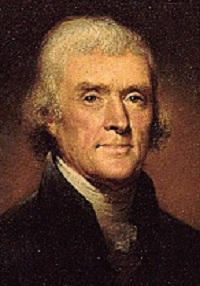 Thomas Jefferson
Thomas Jefferson
1743-1826
Thomas Jefferson (April 13, 1743-July 4, 1826) was an American Founding Father who was the principal author of the United States Declaration of Independence (1776) and the third president of the United States (1801-1809).
At the beginning of the American Revolution, Jefferson served in the Continental Congress, representing Virginia. He then served as a wartime Governor of Virginia (1779-1781), barely escaping capture by the British in 1781. Just after the war ended, from mid-1784, Jefferson served as a diplomat stationed in Paris, initially as a commissioner to help negotiate commercial treaties. In May 1785, he became the U.S. Minister to France. He was the first U.S. Secretary of State (1790-1793). During the administration of President George Washington, Jefferson advised against a national bank and the Jay Treaty. Upon leaving office, with his close friend James Madison he organized the Democratic-Republican Party to oppose Treasury Secretary Alexander Hamilton’s policies, especially his desire to create a national bank. As vice president opposed to John Adams, Jefferson with Madison secretly wrote the Kentucky and Virginia Resolutions, which attempted to nullify the Alien and Sedition Acts and formed the basis of states’ rights. Jefferson also held secret talks with the French against Adams, actions that would likely have had him impeached if known.
Elected president in what Jefferson called the Revolution of 1800, he oversaw a peaceful transition of power, purchased the vast Louisiana Territory from France (1803) and sent the Lewis and Clark Expedition (1804-1806) to explore the new west. Slavery already existed in the acquired territory and Congress did not pass laws to prohibit it. This contributed to the crisis of the Union half a century later. His second term was beset with troubles at home, such as the failed treason trial of his former vice president, Aaron Burr, and escalating trouble with Britain. Jefferson always distrusted Britain as a threat to American values. With Britain at war with Napoleon, he tried aggressive economic warfare; however, his embargo laws did more damage to American trade and the economy and provoked a furious reaction in the Northeast.
Jefferson was part of the Virginia planter elite and, as a tobacco planter, owned hundreds of slaves throughout his lifetime. Like many of his contemporaries, he viewed Africans as being racially inferior. He remained a widower for the rest of his life after his wife of 11 years, Martha Jefferson, died in childbirth. Their marriage produced six children. Even though there is some disagreement on the subject, modern Jeffersonian scholarship generally acknowledges that Jefferson was likely the father of all of his slave Sally Hemings’ six children.
A leader in the Enlightenment, Jefferson was a polymath who spoke five languages and was deeply interested in science, religion and philosophy. His interests led him to assist in founding the University of Virginia in his post-presidency years. While not an orator, he was an indefatigable letter writer and corresponded with many influential people in America and Europe. His views on slavery were complex and changed over the course of his life. He was a leading American opponent of the international slave trade and presided over its abolition in 1807. In the past, Jefferson has often been rated in scholarly surveys as one of the greatest U.S. presidents though, since the mid-20th century, historians have increasingly criticized him, particularly on the issue of slavery.
Jefferson’s health began to deteriorate by July 1825 and, by June 1826, he was confined to bed. His death was from a combination of illnesses and conditions including uremia, severe diarrhea and pneumonia. Jefferson died on July 4, 1826, the 50th anniversary of the Declaration of Independence, only a few hours before John Adams passed away.
Source: http://en.wikipedia.org/wiki/Thomas_Jefferson
 Bibliography
Bibliography
Press your browser’s BACK button to return to the previous page.
 Gish Jen
Gish Jen
1955-
Gish Jen (born Lillian Jen, nicknamed for the actress Lillian Gish, in 1955, in Long Island, New York) is a contemporary American writer.
Gish Jen is a second-generation Chinese-American. Her parents emigrated from China in the 1940s, her mother from Shanghai and her father from Yixing. She grew up in Queens, New York, then Yonkers, then Scarsdale. She graduated from Harvard University in 1977 with a B.A. in English and later attended Stanford Business School (1979-1980) but dropped out in favor of the University of Iowa Writers’ Workshop, where she earned her M.F.A. in fiction in 1983.
Several of her short stories have been reprinted in The Best American Short Stories. Her works include four novels: Typical American, Mona in the Promised Land, The Love Wife and World and Town. She has also written a collection of short fiction, Who’s Irish?
Source: http://en.wikipedia.org/wiki/Gish_Jen
 Bibliography
Bibliography
Press your browser’s BACK button to return to the previous page.
 Jerome, K. Jerome
Jerome, K. Jerome
1859-1927
Jerome Klapka Jerome (May 3, 1859-June 14, 1927) was an English writer and humorist. He was the fourth child of Jerome Clapp (who later renamed himself Jerome Clapp Jerome), an ironmonger and lay preacher who dabbled in architecture, and Marguerite Jones. Owing to bad investments in the local mining industry, the family suffered poverty and debt collectors often visited, an experience Jerome described vividly in his autobiography, My Life and Times (1926).
The young Jerome wished to go into politics or be a man of letters, but the death of his father at age 13, and his mother at age 15, forced him to quit his studies and find work to support himself. He was employed at the London and North Western Railway, initially collecting coal that fell along the railway, and remained there for four years.
In 1877, Jerome decided to try his hand at acting, under the stage name Harold Crichton. He joined a repertory troupe that produced plays on a shoestring budget. After three years on the road and with no evident success, the 21-year-old Jerome decided he had had enough with stage life and sought other occupations. He tried to become a journalist, writing essays, satires and short stories, but most of these were rejected. Over the next few years he was a school teacher, a packer and a solicitor’s clerk. Finally, in 1885, he had some success with On the Stage – and Off, a comic memoir of his experiences with the acting troupe. Idle Thoughts of an Idle Fellow, a collection of humorous essays, followed in 1886. He is best known for the humorous travelogue, Three Men in a Boat. Other works include a second essay collection, Second Thoughts of an Idle Fellow; Three Men on the Bummel, a sequel to Three Men in a Boat; and several other novels.
In June 1927, on a motoring tour from Devon to London via Cheltenham and Northampton, Jerome suffered a paralytic stroke and a cerebral hemorrhage. He lay in Northampton General Hospital for two weeks before succumbing on June 14.
Source: http://en.wikipedia.org/wiki/Jerome_K._Jerome
 Bibliography
Bibliography
Press your browser’s BACK button to return to the previous page.
 Sarah Orne Jewett
Sarah Orne Jewett
1849-1909
Sarah Orne Jewett (September 3, 1849-June 24, 1909) was an American novelist and short story writer, best known for her local color works set in or near South Berwick, Maine, on the border of New Hampshire, which in her day was a declining New England seaport.
Jewett’s family had been residents of New England for many generations. Her father was a doctor and Jewett often accompanied him on his rounds, becoming acquainted with the sights and sounds of her native land and its people. As treatment for rheumatoid arthritis, a condition that developed in early childhood, Jewett was sent on frequent walks and through them also developed a love of nature. In later life, Jewett often visited Boston, where she was acquainted with many of the most influential literary figures of her day; but she always returned to South Berwick, the inspiration for the towns of “Deephaven” and “Dunnet Landing” in her stories.
Jewett was educated at Miss Olive Rayne’s school and then at Berwick Academy, graduating in 1865. She supplemented her education through an extensive family library. Jewett was “never overtly religious” but, after she joined the Episcopalian church in 1871, she explored less-conventional religious ideas. For example, her friendship with Harvard law professor Theophilus Parsons stimulated an interest in the teachings of Emanuel Swedenborg, an 18th century Swedish scientist and theologian, who believed that the Divine “was present in innumerable, joined forms – a concept underlying Jewett’s belief in individual responsibility.”
She published her first important story in The Atlantic Monthly at age 19 and her reputation grew throughout the 1870s and 1880s. Her literary importance arises from her careful, if subdued, vignettes of country life that reflect a contemporary interest in local color rather than plot. Jewett possessed a keen descriptive gift that William Dean Howells called “an uncommon feeling for talk – I hear your people.” Jewett made her reputation with the novella, The Country of the Pointed Firs (1896). A Country Doctor (1884), a novel reflecting her father and her early ambitions for a medical career, and A White Heron (1886), a collection of short stories, are among her finest work. Some of Jewett’s poetry was collected in Verses (1916) and she also wrote three children’s books. Willa Cather described Jewett as a significant influence on her development as a writer, and “feminist critics have since championed her writing for its rich account of women’s lives and voices.”
Jewett never married but she established a close friendship with writer Annie Fields (1834-1915) and her husband, publisher James Thomas Fields, editor of The Atlantic Monthly. After the sudden death of James Fields in 1881, Jewett and Annie Fields lived together for the rest of Jewett’s life in what was then termed a “Boston marriage.” Some modern scholars have speculated that the two were lovers. In any case, “the two women found friendship, humor and literary encouragement” in one another’s company, traveling to Europe together and hosting “American and European literati.” In France, Jewett met Therese Blanc-Bentzon, with whom she had long corresponded and who translated some of her stories for publication in France.
On September 3, 1902, Jewett was injured in a carriage accident that all but ended her writing career. She was paralyzed by a stroke in March 1909 and died on June 24 after suffering another.
Source: http://en.wikipedia.org/wiki/Sarah_Orne_Jewett
 Bibliography
Bibliography
Press your browser’s BACK button to return to the previous page.
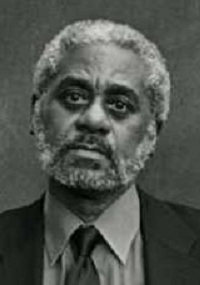 Charles R. Johnson
Charles R. Johnson
1948-
Charles R. Johnson (born April 23, 1948) is an African-American scholar and the author of novels, short stories and nonfiction essays.
Johnson was born in Evanston, Illinois. He first came to prominence in the 1960s as a political cartoonist, at which time he was also involved in radical politics. In 1970, he published a collection of cartoons and this led to a television series about cartooning on PBS. Johnson’s first novel, Faith and the Good Thing, was published in 1974. In 1990, he was awarded the National Book Award for the novel, Middle Passage.
Johnson received his B.S. and M.A. from Southern Illinois University in 1971 and 1973, respectively; he got his Ph.D in philosophy from SUNY-Stony Brook in 1988. In 1976, Johnson was hired to teach at the University of Washington in Seattle, Washington. In 1977, he became a Buddhist.
Recently retired, Johnson was the S. Wilson and Grace M. Pollock Endowed Professor of English at the University of Washington and is a MacArthur Fellow. He is also the recipient of a Guggenheim Fellowship. In 2003, he published Turning the Wheel, a collection of essays about his experiences as an African-American Buddhist.
Source: http://en.wikipedia.org/wiki/Charles_R._Johnson
 Bibliography
Bibliography
Press your browser’s BACK button to return to the previous page.
 Charles Spurgeon Johnson
Charles Spurgeon Johnson
1893-1956
Charles Spurgeon Johnson (July 24, 1893-October 27, 1956) was a distinguished American sociologist, first black president of historically black Fisk University and a lifelong advocate for racial equality and the advancement of civil rights for African-Americans and all other ethnic minorities. He preferred to work quietly in coalition with liberal white groups in the South as a “sidelines activist” concerned to get practical results. His position is often contrasted with that of the towering figure in this field, W.E.B. Du Bois, who was a powerful and militant advocate for his people and who described Johnson as “too conservative.” But this contrast should be seen in the context of the 1930s and 1940s, with complete segregation and fierce discrimination pervading the South. He was angry and unwavering in personal terms in his opposition to this oppressive system yet hoped he had the strategy to significantly change race relations in terms of the short-term practical gains.
Born in the South in turn-of-the century Bristol, Virginia, Johnson went north to Chicago and the University of Chicago, where he was part of the Great Migration. After the tragic race riot of 1919, he did much of the research that showed how the riot had deep roots in denial of economic and social opportunity to African-Americans. His subsequent book, The Negro in Chicago, became the classic model for comprehensive commission reports.
In the 1920s, Johnson moved to New York City, where he became research director for the National Urban League and “entrepreneur of the Harlem Renaissance,” the creative upsurge by African-American writers and artists of that time.
Johnson yearned to return to the South, not only to study race relations but to change them. He moved to Nashville, taking a position as head of sociology at Fisk University. There, he wrote or directed countless studies of the way in which combined economic and social factors produced an oppressive racial structure. Two of these books have become classics: Shadow of the Plantation (1934) and Growing up in the Black Belt (1940). Johnson lived long enough to celebrate the landmark Supreme Court decision, Brown v. Board of Education, which declared racial segregation in the public schools unconstitutional. Johnson played a key role in the effort to implement the decision in the face of “massive resistance.” Johnson’s work and that of his peers helped pave the way for the civil rights legislation of the ’60s.
Johnson was a member of Alpha Phi Alpha, the first intercollegiate Greek-letter fraternity established for African-Americans. He was also a charter member of the Zeta Rho chapter of Phi Mu Alpha Sinfonia music fraternity, chartered at Fisk in 1953.
Source: http://en.wikipedia.org/wiki/Charles_S._Johnson
 Bibliography
Bibliography
Press your browser’s BACK button to return to the previous page.
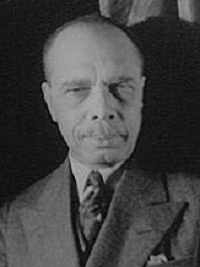 James Weldon Johnson
James Weldon Johnson
1871-1938
James Weldon Johnson (June 17, 1871-June 26, 1938) was an American author, politician, diplomat, critic, journalist, poet, anthologist, educator, lawyer, songwriter and early civil rights activist. Johnson is remembered best for his leadership within the NAACP, as well as for his writing, which includes novels, poems and collections of folklore. He was also one of the first African-American professors at New York University. Later in life, he was a professor of creative literature and writing at Fisk University.
Johnson was born in Jacksonville, Florida, the son of Helen Louise Dillet and James Johnson. His brother was the composer, J. Rosamond Johnson. Johnson was first educated by his mother (a musician and a public school teacher – the first female, black teacher in Florida at a grammar school) and then at Edwin M. Stanton School. His mother imparted to him her considerable love and knowledge of English literature and the European tradition in music. At the age of 16, he enrolled at Atlanta University, from which he graduated in 1894. In addition to his bachelor’s degree, he also completed some graduate coursework there. The achievement of his father, headwaiter at the St. James Hotel, a luxury establishment built when Jacksonville was one of Florida’s first winter havens, gave young James the wherewithal and the self-confidence to pursue a professional career.
He served in several public capacities over the next 35 years, working in education, the diplomatic corps, civil rights activism, literature, poetry and music.
During his six-year diplomatic service in Hispanic America, he completed his most famous book, The Autobiography of an Ex-Colored Man, which was published anonymously in 1912. Other works include: The Book of American Negro Spirituals (1925), Black Manhattan (1930) and Negro Americans, What Now? (1934), a book advocating civil rights for African-Americans.
In 1922, he edited The Book of American Negro Poetry. One of the works for which he is best remembered today, God’s Trombones: Seven Negro Sermons in Verse, was published in 1927 and celebrates the tradition of the folk preacher. In 1917, Johnson published 50 Years and Other Poems.
Employed from 1916 by the National Association for the Advancement of Colored People (NAACP) as a field secretary, he built and revived local chapters of that organization. Opposing race riots in Northern cities and the lynchings that pervaded the South during and immediately after the end of World War I, Johnson engaged the NAACP in mass demonstrations, such as a silent protest parade of more than 10,000 African-Americans down New York City’s Fifth Avenue on July 28, 1917. In 1919, he coined the term “Red Summer” and organized peaceful protests against the racial violence of that year.
In 1920, Johnson was elected to manage the NAACP, the first African-American to hold this position. While serving the NAACP from 1914 through 1930, Johnson started as an organizer and eventually became the first black male secretary in the organization’s history. In 1920, he was sent by the NAACP to investigate conditions in Haiti, which had been occupied by U.S. Marines since 1915. Johnson published a series of articles in The Nation, in which he described the American occupation as being brutal and offered suggestions for the economic and social development of Haiti. These articles were reprinted under the title, Self-Determining Haiti. Throughout the 1920s, he was one of the major inspirations and promoters of the Harlem Renaissance trying to refute condescending white criticism and helping young black authors to get published.
James Weldon Johnson died in 1938 while vacationing in Wiscasset, Maine, when the car he was driving was hit by a train. His funeral in Harlem was attended by more than 2,000 people.
Source: http://en.wikipedia.org/wiki/James_Weldon_Johnson
 Bibliography
Bibliography
Press your browser’s BACK button to return to the previous page.
 Samuel Johnson
Samuel Johnson
1709-1784
Samuel Johnson was born in Litchfield, Staffordshire, England, on September 18, 1709, the son of Michael Johnson and Sarah Ford. His father was a bookseller and Johnson owed much of his education to the fact that he grew up in the bookstore.
Johnson was educated at the Litchfield Grammar School, where he learned Latin and Greek. He later studied with a minister in a nearby village. In 1728 and 1729, Johnson spent 14 months at Pembroke College, Oxford. Too poor and embarrassed by his poverty, Johnson could not complete the work for a degree. He supported himself with teaching jobs after his father died in 1731. In 1735, he married Elizabeth Porter, a widow some 20 years older than himself. Still trying to find a way to make a living, Johnson opened a boarding school, which had only three pupils.
In the early 1750s, Johnson, writing at the rate of two essays a week, published two collections, The Rambler (1750-52) and The Adventurer (1753-54). He also continued work on a dictionary of the English language, a project he had begun in 1746 with the help of six assistants. The project was finally completed in 1755.
Johnson’s Rasselas, Prince of Abissinia, a moral fable concerned with an innocent young man’s search for the secret of happiness, appeared in 1759. The work was immediately successful; six editions and a number of translations appeared during Johnson’s lifetime. In 1762, Johnson accepted a yearly pension of £300 from King George III (1738-1820).
In 1765, Johnson published an eight-volume edition of The Works of William Shakespeare (1564-1616). In 1773, James Boswell persuaded Johnson to join him in a tour of Scotland and both men recorded their trip – Johnson’s A Journey to the Western Islands of Scotland (1775) and Boswell’s Journal.
Johnson’s last great work, the 10-volume Prefaces, Biographical and Critical, to the Works of the English Poets (better known as the Lives of the Poets), was completed when he was 72.
Johnson died on December 13, 1784, in his house in London and he was buried in Westminster Abbey.
Source: http://www.notablebiographies.com/Jo-Ki/Johnson-Samuel.html
 Bibliography
Bibliography
Press your browser’s BACK button to return to the previous page.
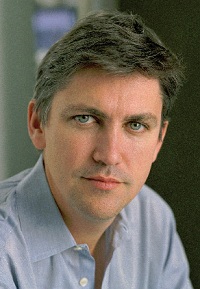 Steven Johnson
Steven Johnson
1968-
Steven Berlin Johnson (born June 6, 1968) is an American popular science author.
Steven Johnson has worked as a columnist for magazines such as Discover Magazine, Slate and Wired. He co-founded the early webzine, Feed Magazine, in 1995, and the Webby-award-winning news discussion site, Plastic.com, in 2001. He is a Distinguished Writer in Residence at New York University.
He is the author of the bestselling book, Everything Bad Is Good for You: How Today’s Popular Culture Is Actually Making Us Smarter (2005), which argues that over the past three decades popular cultural artifacts (like television dramas and video games) have become increasingly complex and have helped to foster higher-order thinking skills. On March 5, 2009, he appeared on The Colbert Report to promote his new book, The Invention of Air.
In 2006, he announced a new online service, Outside.in, which he described as “an attempt to collectively build the geographic Web, neighborhood by neighborhood.”
Source: http://en.wikipedia.org/wiki/Steven_Berlin_Johnson
 Bibliography
Bibliography
Press your browser’s BACK button to return to the previous page.
 Edward P. Jones
Edward P. Jones
1951-
Edward Paul Jones (born 1951) is an American novelist and short story writer. His 2003 novel, The Known World, received the Pulitzer Prize for Fiction.
Jones was born and raised in Washington, D.C., and educated at both the College of the Holy Cross and the University of Virginia.
His first book, Lost in the City, is a collection of short stories about the African-American working class in 20th century Washington, D.C. His second book, The Known World, won the 2004 Pulitzer Prize for Fiction and the 2005 International IMPAC Dublin Literary Award. Jones’ third book, All Aunt Hagar’s Children, was published in 2006.
In the spring and fall semesters of 2009, Jones was a visiting professor of creative writing at the George Washington University. In fall 2010, he joined the English department faculty to teach creative writing.
Source: http://en.wikipedia.org/wiki/Edward_P._Jones
 Bibliography
Bibliography
Press your browser’s BACK button to return to the previous page.
 Gayl Jones
Gayl Jones
1949-
Gayl Jones (born November 23, 1949) is an African-American writer from Lexington, Kentucky.
After earning the Frances Steloff Award for Fiction while attending Connecticut College, Jones graduated with a master’s degree in creative writing at Brown University.
The same year, she published her first book, Corregidora. She was Associate Professor at the University of Michigan. Ever since leaving that post, Jones has kept her life private in order to concentrate on her writing. Her papers are currently housed at the Howard Gotlieb Archival Research Center at Boston University.
Source: http://en.wikipedia.org/wiki/Gayl_Jones
 Bibliography
Bibliography
Press your browser’s BACK button to return to the previous page.
 Tommy Lee Jones
Tommy Lee Jones
1946-
Tommy Lee Jones (born September 15, 1946) is an American actor and film director. He has received three Academy Award nominations, winning one as Best Supporting Actor for the 1993 thriller film, The Fugitive.
His notable film roles include: federal marshal Samuel Gerard in The Fugitive, and its sequel, U.S. Marshals; the villain “Two-Face” in Batman Forever; terrorist William Strannix in Under Siege; Agent K in the Men in Black films; former Texas Ranger Woodrow F. Call in Lonesome Dove; Ed Tom Bell in No Country for Old Men; a Texas Ranger in Man of the House; and rancher Pete Perkins in The Three Burials of Melquiades Estrada. Jones has also portrayed real-life figures such as businessman Howard Hughes, executed murderer Gary Gilmore, Oliver Lynn in Coal Miner’s Daughter and baseball great Ty Cobb.
Jones was born in San Saba, Texas. His mother, Lucille Marie (nee Scott), was a police officer, school teacher and beauty shop owner, and his father, Clyde C. Jones, was an oil field worker. The two were married and divorced twice. Jones has stated that his grandmother was of Cherokee ancestry. He was a resident of Midland, Texas, and attended Robert E. Lee High School.
Jones graduated from the St. Mark’s School of Texas, where he attended on scholarship and is now on the board of directors, and attended Harvard College on a need-based scholarship.
Source: http://en.wikipedia.org/wiki/Tommy_Lee_Jones
 Bibliography
Bibliography
Press your browser’s BACK button to return to the previous page.
 Ben Jonson
Ben Jonson
1572-1637
Ben Jonson was born around June 11, 1572, the posthumous son of a clergyman. He was educated at Westminster School by the great classical scholar, William Camden, and worked in his stepfather’s trade, bricklaying. The trade did not please him in the least and he joined the army, serving in Flanders. He returned to England about 1592 and married Anne Lewis on November 14, 1594.
Jonson joined the theatrical company of Philip Henslowe in London as an actor and playwright on or before 1597, when he is identified in the papers of Henslowe. In 1597, he was imprisoned in the Fleet Prison for his involvement in a satire entitled The Isle of Dogs, declared seditious by the authorities.
Jonson’s second known play, Every Man in His Humour, was performed in 1598 by the Lord Chamberlain’s Men at the Globe with William Shakespeare in the cast. His next play, Every Man Out of His Humour (1599), was less successful.
In The Poetaster (1601), he satirized other writers, chiefly the English dramatists Thomas Dekker and John Marston. In 1604, Jonson collaborated with Dekker on The King’s Entertainment and with Marston and George Chapman on Eastward Ho. Jonson’s next play, the classical tragedy Sejanus, His Fall (1603), again got Jonson into trouble with the authorities.
In 1605, Jonson began to write masques for the entertainment of the court. The earliest of his masques, The Satyr, was performed at Althorpe and Jonson seems to have been appointed Court Poet shortly after. Masque of Blacknesse (1605) was the first in a series of collaborations with Inigo Jones, noted English architect and set designer. This collaboration produced masques such as The Masque of Owles, Masque of Beauty (1608) and Masque of Queens (1609).
Jonson’s enduring reputation rests on the comedies written between 1605 and 1614. The first of these, Volpone, or the Fox (1605-1606), is often regarded as his masterpiece. The following plays, Epicoene: or the Silent Woman (1609), The Alchemist (1610) and Bartholomew Fair (1614) are all peopled with dupes and those who deceive them. Jonson’s keen sense of his own stature as an author is represented by the unprecedented publication of his Works, in folio, in 1616. He was appointed as poet laureate and rewarded a substantial pension in the same year.
The comedy, The Devil Is an Ass (1616), turned out to be a comparative flop. This may have discouraged Jonson, for it was nine years before his next play, The Staple of News (1625), was produced. Instead, Jonson turned his attention to writing masques. Jonson’s later plays, The New Inn (1629) and A Tale of a Tub (1633), were not great successes.
Jonson was appointed City Chronologer of London in 1628, the same year in which he suffered a severe stroke. His loyal friends kept him company in his final years and the king provided him some financial comfort.
Jonson died on August 6, 1637, and was buried in Westminster Abbey.
Source: http://www.luminarium.org/sevenlit/jonson/benbio.htm
 Bibliography
Bibliography
Press your browser’s BACK button to return to the previous page.
 June Jordan
June Jordan
1936-2002
June Jordan was born in New York City in 1936. Her books of poetry include: Kissing God Goodbye: Poems, 1991-1997 (1997), Haruko/Love Poems (1994), Naming Our Destiny: New and Selected Poems (1989), Living Room (1985), Passion (1980) and Things That I Do in the Dark (1977).
She is also the author of children’s books, plays, a novel and Poetry for the People: A Blueprint for the Revolution (1995), a guide to writing, teaching and publishing poetry. Her collections of political essays include Affirmative Acts: Political Essays (1998) and Technical Difficulties (1994). Basic Books published her memoir, Soldier: A Poet’s Childhood, in 2000.
Jordan received a Rockefeller Foundation grant, the National Association of Black Journalists Award and fellowships from the Massachusetts Council on the Arts, the National Endowment for the Arts and the New York Foundation for the Arts. She taught at the University of California, Berkeley, where she founded Poetry for the People.
June Jordan died of breast cancer on June 14, 2002, in Berkeley, California.
Source: http://www.poets.org/poet.php/prmPID/65
 Bibliography
Bibliography
Press your browser’s BACK button to return to the previous page.
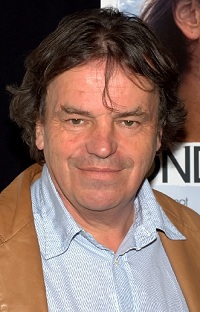 Neil Jordan
Neil Jordan
1950-
Neil Patrick Jordan (born February 25, 1950) is an Irish filmmaker and novelist. He won an Academy Award (Best Original Screenplay) for The Crying Game. He also won the Silver Bear for Best Director at the Berlin International Film Festival for The Butcher Boy.
Jordan was born in County Sligo, the son of Angela (nee O’Brien), a painter, and Michael Jordan, a professor. He was educated at St. Paul’s College, Raheny. Later, Jordan attended University College Dublin, where he studied Irish history and English literature.
When John Boorman was filming Excalibur in Ireland, he recruited Jordan as a script consultant, which led to his doing second unit work. His first feature, Angel, a Tale of a Musician Caught up in the Troubles, starred Stephen Rea, who has subsequently appeared in almost all of Jordan’s films to date.
As a writer/director, Jordan has a highly idiosyncratic body of work, ranging from mainstream hits like Interview with the Vampire to commercial failures like We’re No Angels to a variety of more personal, low-budget arthouse pictures.
Jordan lives in a house on Sorrento Terrace in Dalkey, Ireland.
Source: http://en.wikipedia.org/wiki/Neil_Jordan
 Bibliography
Bibliography
Press your browser’s BACK button to return to the previous page.
 Flavius Josephus
Flavius Josephus
37-100 AD
Josephus (37 AD-c. 100 AD), also known as Yosef Ben Matityahu (Joseph, son of Matthias) and, after he became a Roman citizen, as Titus Flavius Josephus, was a 1st century Jewish historian and apologist of priestly and royal ancestry who survived and recorded the destruction of Jerusalem in 70 AD. His works give an important insight into 1st century Judaism.
Josephus was important in the Roman world for the Jewish people and culture, particularly at a time of conflict and tension. He always remained, in his own eyes, a loyal and law-observant Jew. He went out of his way both to commend Judaism to educated Gentiles and to insist on its compatibility with cultured Graeco-Roman thought. He constantly contended for the antiquity of Jewish culture, presenting its people as civilized, devout and philosophical.
Josephus’ two most important works are The Jewish War (c. 75) and Antiquities of the Jews (c. 94). The Jewish War recounts the Jewish revolt against Rome (66-70). Antiquities of the Jews recounts the history of the world from a Jewish perspective. These works provide valuable insight into 1st century Judaism and the background of early Christianity.
Source: http://en.wikipedia.org/wiki/Josephus
 Bibliography
Bibliography
Press your browser’s BACK button to return to the previous page.
 James Joyce
James Joyce
1882-1941
James Augustine Aloysius Joyce (February 2, 1882-January 13, 1941) was an Irish novelist and poet. Joyce is best known for Ulysses (1922). Other major works are the short-story collection, Dubliners (1914), and the novels A Portrait of the Artist as a Young Man (1916) and Finnegan’s Wake (1939). His complete oeuvre includes three books of poetry, a play, occasional journalism and his published letters.
Joyce was born to John Stanislaus Joyce and Mary Jane Murray in the Dublin suburb of Rathgar. He enrolled at the recently established University College Dublin (UCD) in 1898, studying English, French and Italian. He also became active in theatrical and literary circles in the city. In 1900, his review of Henrik Ibsen’s New Drama was published in Fortnightly Review; it was his first publication and he received a note of thanks from the Norwegian dramatist himself. Joyce wrote a number of other articles and at least two plays (since lost) during this period.
On January 7, 1904, he attempted to publish A Portrait of the Artist, an essay-story dealing with aesthetics, only to have it rejected from the free-thinking magazine, Dana. He decided, on his 22nd birthday, to revise the story into a novel he called Stephen Hero. It was never published in this form but, years later, in Trieste, Joyce completely rewrote it as A Portrait of the Artist as a Young Man. The unfinished Stephen Hero was published after his death.
On January 13, 1941, he died from complications after surgery for a perforated ulcer.
Source: http://en.wikipedia.org/wiki/James_Joyce
 Bibliography
Bibliography
Press your browser’s BACK button to return to the previous page.
 Juvenal (Juvenalis, Decimus)
Juvenal (Juvenalis, Decimus)
Late first century AD
Decimus Iunius Iuvenalis, known in English as Juvenal, was a Roman poet active in the late 1st and early 2nd centuries AD and author of The Satires. The details of the author’s life are unclear, although references within his text to known persons of the late 1st and early 2nd centuries AD fix his terminus post quem (earliest date of composition).
In accord with the vitriolic manner of Lucilius – the originator of the genre of Roman satire – and within a poetic tradition that also included Horace and Persius, Juvenal wrote at least 16 poems in dactylic hexameter covering an encyclopedic range of topics across the Roman world. While The Satires are a vital source for the study of ancient Rome from a vast number of perspectives, their hyperbolic, comedic mode of expression makes the use of statements found within them as simple fact problematic.
The precise details of the author’s life cannot be securely reconstructed based on presently available evidence. The Vita Iuvenalis (Life of Juvenal), a biography of the author that became associated with his manuscripts no later than the 10th century, is little or nothing more than extrapolation from The Satires themselves.
The traditional biographies, including the Vita Iuvenalis, give us the writer’s full name and also tell us that he was either the son or adopted son of a rich freedman. He is supposed to have been a pupil of Quintillian and to have practiced rhetoric until he was middle-aged, both as amusement and for legal purposes (The Satires make both frequent and accurate references to the operation of the Roman legal system). His career as a satirist is supposed to have begun at a fairly late stage in his life. The biographies agree in giving his birthplace as Aquinum and also agree in allotting to his life a period of exile due to insulting an actor with high levels of court influence: The emperor who banished him is given as either Trajan or Domitian, and all the biographies place his exile in Egypt.
Only one of these traditional biographies supplies a date of birth for Juvenal: it gives 55 AD, which is most probably guesswork but accords reasonably well with the rest of the evidence. Other traditions have him surviving for some time past the year of Hadrian’s death (138 AD). Some sources place this death in exile, others have him being recalled to Rome (the latter of which is considered more plausible by contemporary scholarship). If he was exiled by Domitian, it is then possible that he was one of the political exiles recalled during the brief reign of Nerva.
Source: http://en.wikipedia.org/wiki/Juvenal
 Bibliography
Bibliography
Press your browser’s BACK button to return to the previous page.
 Franz Kafka
Franz Kafka
1883-1924
Franz Kafka (July 3, 1883-June 3, 1924) was a culturally influential German-language author of short stories and novels.
Kafka was born to middle-class, German-speaking Jewish parents in Prague, Bohemia, then part of the Austro-Hungarian Empire. He was also fluent in Czech and took an interest in Czech literature. Later, Kafka acquired some knowledge of French language and culture.
Admitted to the Charles-Ferdinand University of Prague, Kafka first studied chemistry but switched after two weeks to law. This offered a range of career possibilities, which pleased his father, and required a longer course of study that gave Kafka time to take classes in German studies and art history. Kafka obtained the degree of Doctor of Law on June 18. 1906, and performed an obligatory year of unpaid service as law clerk for the civil and criminal courts.
On November 1, 1907, he was hired at the Assicurazioni Generali, an Italian insurance company, where he worked for nearly a year. His correspondence during that period witnesses that he was unhappy with his working schedule as it made it extremely difficult for him to concentrate on his writing. On July 15, 1908, he resigned and two weeks later found more congenial employment with the Worker’s Accident Insurance Institute for the Kingdom of Bohemia.
In 1912, Kafka began to suffer from tuberculosis, which required frequent convalescence, during which he was supported by his family. His condition worsened and he returned to Prague.
He died on June 3, 1924, apparently from starvation.
Source: http://en.wikipedia.org/wiki/Franz_Kafka
 Bibliography
Bibliography
Press your browser’s BACK button to return to the previous page.
 George Kaufman
George Kaufman
1889-1961
George Simon Kaufman (November 16, 1889-June 2, 1961) was an American playwright, theatre director and producer, humorist and drama critic. In addition to comedies and political satire, he wrote several musicals, notably for the Marx Brothers. One play and one musical that he wrote won the Pulitzer Prize for Drama: You Can’t Take It with You (1937) and Of Thee I Sing (1932). He also won the Tony Award as a director for the musical, Guys and Dolls.
Born to a Jewish family in Pittsburgh, Pennsylvania, he graduated from high school in 1907 and “tried law school for three months” but grew disenchanted and took on a series of odd jobs, including “selling hatbands.” Kaufman then began his career as a journalist and drama critic; he was the drama editor for The New York Times from 1917 through 1930.
Kaufman’s Broadway debut was September 4, 1918, at the Knickerbocker Theatre, with the premiere of the melodrama, Someone in the House.
In every Broadway season from 1921 through 1958, there was a play written or directed by Kaufman.
Kaufman died in New York City on June 2, 1961, at the age of 71.
Source: http://en.wikipedia.org/wiki/George_S._Kaufman
 Bibliography
Bibliography
Press your browser’s BACK button to return to the previous page.
 Jackie Kay
Jackie Kay
1961-
Jackie Kay was born in Glasgow in 1961 to a Scottish mother and a Nigerian father. She was adopted by a Scottish white couple, Helen and John Kay, and brought up in Bishopbriggs, a suburb of Glasgow.
Kay grew up in a 1950s-built Glasgow housing estate in a small Wimpey house, which her adoptive parents had bought new in 1957. They adopted Kay in 1961, having already adopted her brother, Maxwell, about two years earlier. Jackie and Maxwell also have siblings who were brought up by their genetic parents. Kay’s adoptive father worked for the Communist Party full-time and stood for Member of Parliament; her adoptive mother was the Scottish secretary of Campaign for Nuclear Disarmament. In August 2007, Kay was the subject of the fourth episode of The House I Grew Up In, in which she talked about a happy childhood in a stimulating, albeit unconventional, home.
Initially harboring ambitions to be an actress, she decided to concentrate on writing after Alasdair Gray, a Scottish artist and writer, read her poetry and told her that writing was what she should be doing. She studied English at the University of Stirling and her first book of poetry, the partially autobiographical The Adoption Papers, was published in 1991 and won the Saltire Society Scottish First Book Award. Her other awards include the 1994 Somerset Maugham Award for Other Lovers and the Guardian First Book Award Fiction Prize for Trumpet, based on the life of American jazz musician, Billy Tipton, born Dorothy Tipton, who lived as a man for the last 50 years of her life.
Kay writes extensively for stage, screen and for children. In 2010, she published Red Dust Road, an account of her search for her birth parents. Her drama, The Lamplighter (2007), is an exploration of the Atlantic slave trade.
Jackie Kay became a Member of the Order of the British Empire (MBE) on June 17, 2006. She is currently Professor of Creative Writing at Newcastle University. She lives in Manchester.
Source: http://en.wikipedia.org/wiki/Jackie_Kay
 Bibliography
Bibliography
Press your browser’s BACK button to return to the previous page.
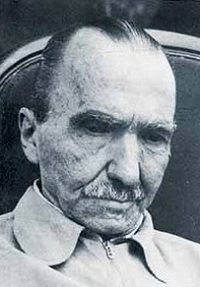 Nikos Kazantzakis
Nikos Kazantzakis
1883-1957
Nikos Kazantzakis (February 18, 1883-October 26, 1957) was a Greek writer and philosopher, celebrated for his novel, Zorba the Greek, considered his magnum opus.
When Kazantzakis was born in 1883 in Heraklion, Crete had not yet joined the modern Greek state, (which had been established in 1832) and was still under the rule of the Ottoman Empire.
From 1902, Kazantzakis studied law at the University of Athens, then went to Paris in 1907 to study philosophy. Upon his return to Greece, he began translating works of philosophy.
Between 1922 and his death in 1957, he sojourned in Paris and Berlin (from 1922 to 1924), Italy, Russia (in 1925), Spain (in 1932) and then later in Cyprus, Aegina, Egypt, Mount Sinai, Czechoslovakia, Nice, China and Japan. While in Berlin, where the political situation was explosive, Kazantzakis discovered communism and became an admirer of Lenin. He never became a consistent communist but visited the Soviet Union and stayed with the Left Opposition politician and writer, Victor Serge. He witnessed the rise of Joseph Stalin and became disillusioned with Soviet-style communism. Around this time, his earlier nationalist beliefs were gradually replaced by a more universal ideology.
In 1945, he became the leader of a small party on the non-communist left and entered the Greek government as Minister without Portfolio. He resigned this post the following year.
Late in 1957, even though suffering from leukemia, he set out on one last trip to China and Japan. Falling ill on his return flight, he was transferred to Freiburg, Germany, where he died.
Source: http://en.wikipedia.org/wiki/Nikos_Kazantzakis
 Bibliography
Bibliography
Press your browser’s BACK button to return to the previous page.
 John Keats
John Keats
1785-1821
English Romantic poet John Keats was born on October 31, 1795, in London. The oldest of four children, he lost both his parents at a young age. After his mother’s death, Keats’ maternal grandmother appointed two London merchants, Richard Abbey and John Rowland Sandell, as guardians. Abbey, a prosperous tea broker, assumed the bulk of this responsibility, while Sandell played only a minor role. When Keats was 15, Abbey withdrew him from the Clarke School, Enfield, to apprentice with an apothecary-surgeon and study medicine in a London hospital. In 1816, Keats became a licensed apothecary but he never practiced his profession, deciding instead to write poetry.
Around this time, Keats met Leigh Hunt, an influential editor of The Examiner, who published his sonnets “On First Looking into Chapman’s Homer” and “O Solitude.” Hunt also introduced Keats to a circle of literary men, including the poets Percy Bysshe Shelley and William Wordsworth. The group’s influence enabled Keats to see his first volume, Poems by John Keats, published in 1817. Shelley, who was fond of Keats, had advised him to develop a more substantial body of work before publishing it. Keats, who was not as fond of Shelley, did not follow his advice.
“Endymion,” a 4,000-line erotic/allegorical romance based on the Greek myth of the same name, appeared the following year. Two of the most influential critical magazines of the time, The Quarterly Review and Blackwood’s Magazine, attacked the collection.
Keats spent the summer of 1818 on a walking tour in Northern England and Scotland, returning home to care for his brother, Tom, who suffered from tuberculosis. Writing some of his finest poetry between 1818 and 1819, Keats mainly worked on “Hyperion,” a Miltonic blank-verse epic of the Greek creation myth. He stopped writing “Hyperion” upon the death of his brother, completing only a small portion, but in late 1819 he returned to the piece and rewrote it as “The Fall of Hyperion” (unpublished until 1856). That same autumn, Keats contracted tuberculosis and, by the following February, he felt that death was already upon him, referring to the present as his “posthumous existence.”
In July 1820, he published his third and best volume of poetry, Lamia, Isabella, The Eve of St. Agnes and Other Poems. The volume also contains the unfinished “Hyperion” and three poems considered among the finest in the English language: “Ode on a Grecian Urn,” “Ode on Melancholy” and “Ode to a Nightingale.” The book received enthusiastic praise.
Under his doctor’s orders to seek a warm climate for the winter, Keats went to Rome with his friend, the painter Joseph Severn. He died there on February 23, 1821, at the age of 25.
Source: http://www.poets.org/poet.php/prmPID/66
 Bibliography
Bibliography
Press your browser’s BACK button to return to the previous page.
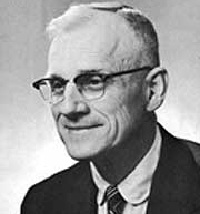 Harold Keith
Harold Keith
1903-1998
Harold Verne Keith (1903-February 24, 1998) was a Newbery Medal-winning American author. Keith was born and raised in Oklahoma, where he also lived and died: The state was his abiding passion. He used Oklahoma as the setting for most of his books, although Rifles for Watie takes place elsewhere.
Keith was born in 1903 in Lambert, Oklahoma Territory. He attended Northwestern State Teachers College and the University of Oklahoma, where he earned a master’s degree in history and was also sports editor for the student newspaper. During the work for his master’s thesis, he interviewed 22 veterans of the Civil War who lived in the area. From 1922-1923, he was a teacher in the Aorita Consolidated School System. Keith served as the University of Oklahoma Sports Publicity Director from 1930-1969. He had a continuing interest in long-distance running.
He died in Norman, Oklahoma, of congestive heart failure on February 24, 1998.
Source: http://en.wikipedia.org/wiki/Harold_Keith
 Bibliography
Bibliography
Press your browser’s BACK button to return to the previous page.
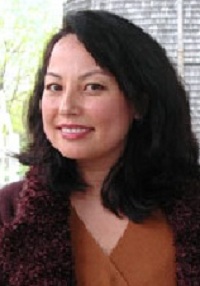 Nora Okja Keller
Nora Okja Keller
1965-
Nora Okja Keller (born December 22, 1965, in Seoul, South Korea) is a Korean-American author. Her 1997 breakthrough work of fiction, Comfort Woman, and the 2002 sequel, Fox Girl, focus on multigenerational trauma resulting from Korean women’s experiences as sex slaves, euphemistically called comfort women, for Japanese troops during World War II.
Keller was raised primarily by her Korean mother, Tae Im Beane, in Hawaii and identifies her ethnicity as Korean-American. Her father, Robert Cobb, however, was a German computer engineer. She has lived in Hawaii from the age of three.
Keller is a graduate of the Punahou School in Honolulu. She received her B.A. from the University of Hawaii with a double major in psychology and English and worked in Honolulu as a freelance writer, including at The Honolulu Star-Bulletin, a newspaper. She earned an M.A. and a Ph.D in American Literature from the University of California at Santa Cruz. She now works as an English teacher at Punahou School.
Source: http://en.wikipedia.org/wiki/Nora_Okja_Keller
 Bibliography
Bibliography
Press your browser’s BACK button to return to the previous page.
 Margery Kempe
Margery Kempe
1373-1439?
Margery Kempe (c. 1373-after 1438) is known for dictating The Book of Margery Kempe, a work considered by some to be the first autobiography in the English language. This book chronicles, to some extent, her extensive pilgrimages to various holy sites in Europe and Asia, as well as her mystical conversations with God. She is honored in the Anglican Communion.
She was born Margery Brunham in King’s Lynn (then Bishop’s Lynn), Norfolk, Kingdom of England. At the age of 20, Margery Brunham married a Norwich man named John Kempe. She had 14 children with him.
The narrative of Kempe’s book begins just after her marriage and relates the experience of her difficult first pregnancy. While delivering this child, she became gravely ill and feared for her life. She called for a priest to hear her confession, as she had a “secret sin” that had been weighing on her conscience for some time. The priest began to censure her before she could divulge this sin in its entirety, and then left. Fearing eternal damnation, she fell into a delusional state, where she describes seeing devils around her, and was considered a danger to herself and others. She was chained in a storeroom for six months until, as she describes, Jesus sat down at her bedside and asked her, “Daughter, why hast thou forsaken Me, and I forsook never thee?” She relates, at first, intending to become God’s servant but admits she could not “leave her pride nor her pompous array.”
Though she tried to be more devout, she was tempted by sexual pleasures and social jealousy for some years. Eventually, Kempe dedicated herself completely to the spiritual calling that she felt her earlier vision required. Striving to live a life of commitment to God, Kempe negotiated a celibate marriage with her husband and began to make pilgrimages around Europe and Asia to holy sites, including Rome, Jerusalem and Santiago de Compostela. Her book consisted of her accounts related to these travels, although a final section includes a series of prayers. The spiritual focus of her book is on the mystical conversations she conducts with Christ for more than 40 years.
In 1438, the year her book is known to have been completed, a Marguerite Kempe, who may have been Margery Kempe, was admitted to the Trinity Guild of Lynn. The last record of her is in the town of Lynn in 1438 but it is not positively known when and where she died.
Kempe’s book was essentially lost for centuries until a manuscript was found by Hope Emily Allen in the private library of the Butler-Bowdon family in Lancashire in 1934. It has since been reprinted in numerous editions and inspired numerous spiritual seekers, as well as scholars trying to understand the role of women in the Middle Ages.
Source: http://en.wikipedia.org/wiki/Margery_Kempe
 Bibliography
Bibliography
Press your browser’s BACK button to return to the previous page.
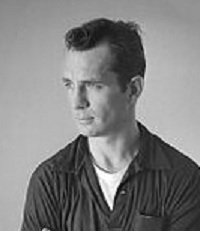 Jack Kerouac
Jack Kerouac
1922-1969
Jean-Louis “Jack” Kerouac (March 12, 1922-October 21, 1969) was an American novelist and poet. He is considered a literary iconoclast and, along with William S. Burroughs and Allen Ginsberg, a pioneer of the Beat Generation. Kerouac is recognized for his spontaneous method of writing, covering topics such as Catholic spirituality, jazz, promiscuity, Buddhism, drugs, poverty and travel.
Kerouac became an underground celebrity and, with other beats, a progenitor of the hippie movement, although he remained antagonistic toward some of its politically radical elements.
In 1969, at age 47, Kerouac died from internal bleeding due to longstanding abuse of alcohol.
Source: http://en.wikipedia.org/wiki/Jack_Kerouac
 Bibliography
Bibliography
Press your browser’s BACK button to return to the previous page.
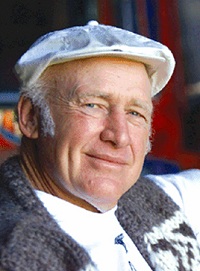 Ken Kesey
Ken Kesey
1935-2001
Kenneth Elton “Ken” Kesey (September 17, 1935-November 10, 2001) was an American author best known for his novel, One Flew Over the Cuckoo’s Nest (1962), and as a counter-cultural figure who considered himself a link between the Beat Generation of the 1950s and the hippies of the 1960s.
Kesey was born in La Junta, Colorado, to dairy farmers Frederick A. Kesey and Geneva Smith. In 1946, the family moved to Springfield, Oregon. Kesey was a champion wrestler in both high school and college in the 174-pound weight division, and he almost qualified to be on the Olympic team until a serious shoulder injury stopped his wrestling career. He graduated from Springfield High School in 1953.
Kesey attended the University of Oregon’s School of Journalism, where he received a degree in speech and communication in 1957, and was a brother of Beta Theta Pi. He was awarded a Woodrow Wilson National Fellowship in 1958 to enroll in the creative writing program at Stanford University, which he did the following year. While at Stanford, he studied under Wallace Stegner and began the manuscript that would become One Flew Over the Cuckoo’s Nest.
Kesey was diagnosed with diabetes in 1992. In 1997, health problems began to take their toll, starting with a stroke that year. On October 25, 2001 Kesey had surgery on his liver to remove a tumor. He never recovered from the operation and died of complications on November 10, 2001, age 66.
Source: http://en.wikipedia.org/wiki/Ken_Kesey
 Bibliography
Bibliography
Press your browser’s BACK button to return to the previous page.
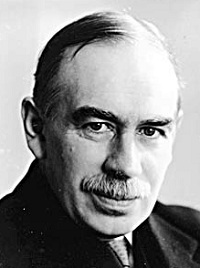 John Maynard Keynes
John Maynard Keynes
1883-1946
John Maynard Keynes, Baron Keynes of Tilton (June 5, 1883-April 21, 1946), was a British economist whose ideas have profoundly affected the theory and practice of modern macroeconomics, as well as the economic policies of governments. He greatly refined earlier work on the causes of business cycles and advocated the use of fiscal and monetary measures to mitigate the adverse effects of economic recessions and depressions. His ideas are the basis for the school of thought known as Keynesian economics, as well as its various offshoots.
In the 1930s, Keynes spearheaded a revolution in economic thinking, overturning the older ideas of neoclassical economics that held that free markets would in the short to medium term automatically provide full employment, as long as workers were flexible in their wage demands. Keynes instead argued that aggregate demand determined the overall level of economic activity and that inadequate aggregate demand could lead to prolonged periods of high unemployment. Following the outbreak of World War II, Keynes’ ideas concerning economic policy were adopted by leading Western economies. During the 1950s and 1960s, the success of Keynesian economics resulted in almost all capitalist governments adopting its policy recommendations, promoting the cause of social liberalism.
Keynes is widely considered to be one of the founders of modern macroeconomics and the most influential economist of the 20th century. In addition to being an economist, Keynes was also a civil servant, a director of the Bank of England, a patron of the arts and an art collector, a part of the Bloomsbury Group of intellectuals, an adviser to several charitable trusts, a writer, a philosopher, a private investor and a farmer.
Keynes died of a heart attack at Tilton, his farmhouse home near Firle, East Sussex, England, on April 21, 1946, at the age of 62.
Source: http://en.wikipedia.org/wiki/John_Maynard_Keynes
 Bibliography
Bibliography
Press your browser’s BACK button to return to the previous page.
 Omar Khayyam
Omar Khayyam
1048-1131
Omar Khayyam (born 1048 AD, Neyshapur, Iran-1131 AD, Neyshapur, Iran), was a Persian polymath, mathematician, philosopher, astronomer, physician and poet. He also wrote treatises on mechanics, geography and music.
He has become established as one of the major mathematicians and astronomers of the medieval period. Recognized as the author of the most important treatise on algebra before modern times, as reflected in his Treatise on Demonstration of Problems of Algebra, he gave a geometric method for solving cubic equations by intersecting a hyperbola with a circle. He also contributed to the calendar reform and may have proposed a heliocentric theory well before Copernicus.
His significance as a philosopher and teacher, and his few remaining philosophical works, have not received the same attention as his scientific and poetic writings. Zamakhshari referred to him as “the philosopher of the world.” Many sources have also testified that he taught for decades the philosophy of Ibn Sina in Nishapur, where Khayyam lived most of his life, died and was buried. His mausoleum remains today a masterpiece of Iranian architecture visited by many people every year.
Outside Iran and Persian-speaking countries, Khayyam has had an impact on literature and societies through translation and works of scholars. The greatest such impact was in English-speaking countries; the English scholar Thomas Hyde (1636-1703) was the first non-Persian to study him. However, the most influential of all was Edward FitzGerald (1809-83), who made Khayyam the most famous poet of the East in the West through his celebrated translation and adaptations of Khayyam’s rather small number of quatrains (rubaiyaas) in Rubaiyat of Omar Khayyam.
Source: http://en.wikipedia.org/wiki/Omar_Khayy%C3%A1m
 Bibliography
Bibliography
Press your browser’s BACK button to return to the previous page.
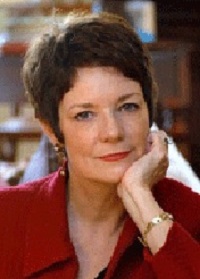 Sue Kidd
Sue Kidd
1948-
Sue Monk Kidd (born August 12, 1948) is a writer from the Southern United States, best known for her novel, The Secret Life of Bees.
Kidd, who was born in Sylvester, Georgia, graduated from Texas Christian University with a B.S. in nursing in 1970 and worked throughout her 20s as a Registered Nurse and college nursing instructor.
She got her start in writing when a personal essay she wrote for a writing class was published in Guideposts and reprinted in Reader’s Digest. She went on to become a contributing editor at Guideposts.
Her first books, God’s Joyful Surprise (1988) and When the Heart Waits (1990), were spiritual memoirs describing her experiences in contemplative Christianity. The Dance of the Dissident Daughter (1996) introduced themes from feminist theology.
Her first novel, The Secret Life of Bees (2002), was written over a period of more than three and a half years. In 2006, Firstlight, a collection of Kidd’s early writings, was released.
Kidd’s next book, Traveling with Pomegranates (2009), co-authored with her daughter, Ann, is a mother-daughter travel memoir.
Kidd is currently Writer-in-Residence at Phoebe Pember House in Charleston.
Source: http://en.wikipedia.org/wiki/Sue_Monk_Kidd
 Bibliography
Bibliography
Press your browser’s BACK button to return to the previous page.
 John Tracy Kidder
John Tracy Kidder
1945-
John Tracy Kidder (born November 12, 1945) is a Pulitzer Prize-winning American writer of the 1981 nonfiction narrative, The Soul of a New Machine, about the creation of a new computer at Data General Corporation.
Kidder was born in New York City. He graduated from Phillips Academy in 1963. He attended Harvard University, originally majoring in political science, but switched to English after taking a course in creative writing from Robert Fitzgerald. He received an A.B. degree from Harvard in 1967.
He served in the U.S. Army as a first lieutenant, Military Intelligence, in Vietnam from 1967 to 1969. After returning from Vietnam, he wrote for some time and then enrolled in the Iowa Writers’ Workshop. He received an M.F.A. degree from the University of Iowa in 1974.
Kidder wrote his first book, The Road to Yuba City: A Journey into the Juan Corona Murders, while at the University of Iowa. His works for Atlantic Monthly include several essays and short stories about the Vietnam War, including “The Death of Major Great” (1974), “Soldiers of Misfortune” (1978) and “In Quarantine” (1980).
His second book, The Soul of a New Machine, was much more successful than his first and won the Pulitzer Prize for General Nonfiction in 1982. He has continued to write nonfiction books and articles that have been well received by the critics.
Kidder’s latest book, Strength in What Remains, is a vivid and moving portrait of a man who survived the genocide in Burundi.
Source: http://en.wikipedia.org/wiki/Tracy_Kidder
 Bibliography
Bibliography
Press your browser’s BACK button to return to the previous page.
 Soren Kierkegaard
Soren Kierkegaard
1813-1855
Soren Kierkegaard was born on May 5, 1813, in Copenhagen. Kierkegaard was influenced early in life by the devoutly religious teachings of his father, which concentrated on Christ’s suffering. In 1830, Kierkegaard went to study theology, philosophy and literature at the University of Copenhagen.
In 1840, he completed his doctoral dissertation, entitled Om Begrebet Ironi (The Concept of Irony). Kierkegaard’s first major book was this dissertation, published in 1841. This, along with many of his other books, was in conflict with Hegelianism, the dominant German philosophy of the time. Contrary to Hegel, Kierkegaard believed in personal immortality and that human life cannot be rationalized in the way that Hegel’s system would understand it. Kierkegaard argued that belief in God is a free act of faith, not a solution to a theoretical problem.
Much of Kierkegaard’s work expresses a deep interest in religious issues, including Frygt og Beven: Dialectisk Lyrik (Fear and Trembling, 1843), Kierkegaard Begrebet Angest (The Concept of Dread, 1844), Purity of Heart Is to Will One Thing (1847) and Sygdomen Til Doden (The Sickness unto Death, 1849). In 1843, Kierkegaard published Either/Or. Also in 1843, he published Fear and Trembling and Repetition. Fear and Trembling is a study of the story of Abraham and Isaac. Repetition works with a similar theme.
In 1846, Kierkegaard published Afsluttende Uvidenskabelig Efterskrift (Concluding Unscientific Postscript), a critique of philosophical system building. In 1847, Kierkegaard wrote Works of Love, a piece on love in its various forms, the perfection of Christian love and the “offense” of Christianity.
In 1848, Kierkegaard had a spiritual crisis. His works after this point began to bluntly attack the church and Christendom’s complacency. He hoped to anger contemporary Christians enough to inspire in them a stronger relationship to their faith. In 1850, he published Indovelse in Christendom (Practice in Christianity) under the pseudonym Anti-Climacus. He felt this to be his most important book and saw it as a reintroduction of Christianity. He felt that the removal of the offense of Christianity by the state church of Denmark made light of the message of Christianity. In a similar tone, he published Guds Foranderlighet in 1855 under his own name. He also wrote articles for a journal called The Fatherland, criticizing the state Lutheran church for claiming that all people born in Denmark are automatically Christian. These articles are compiled under the title, Hvad Christus Dommer Om Officiel Christendom (Attack upon Christendom).
While he was writing the articles that make up Attack upon Christendom, Kierkegaard was stricken with a spinal disease. He died within a month of his diagnosis on November 11, 1855.
Source: http://www.egs.edu/library/soeren-kierkegaard/biography/
 Bibliography
Bibliography
Press your browser’s BACK button to return to the previous page.
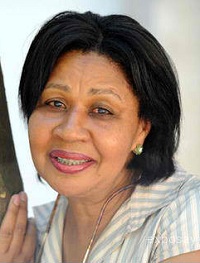 Jamaica Kincaid
Jamaica Kincaid
1949-
Jamaica Kincaid (born May 25, 1949, as Elaine Cynthia Potter Richardson) is a Caribbean novelist, gardener and gardening writer. She was born in the city of St. John’s on the island of Antigua in the nation of Antigua and Barbuda. She lives with her family in North Bennington, Vermont, during the summers and teaches at Claremont McKenna College in Claremont, California, during the academic year.
Kincaid’s short fiction has appeared in The Paris Review and The New Yorker, where her novel, Lucy, was originally serialized. Her first book, At the Bottom of the River (1983), was nominated for the PEN/Faulkner Award for Fiction. She has received the Lannan Literary Award for Fiction, the Prix Femina Etranger, the Anisfield-Wolf Book Award and the Lila Wallace-Reader’s Digest Award.
Source: http://en.wikipedia.org/wiki/Jamaica_Kincaid
 Bibliography
Bibliography
Press your browser’s BACK button to return to the previous page.
 Grace King
Grace King
1851-1932
Grace Elizabeth King (November 29, 1851-January 12, 1932) was an American author of Louisiana stories, history and biography and a leader in historical and literary activities.
Born in New Orleans into an aristocratic family that had been impoverished by the American Civil War, she studied under Charles Gayarre and eventually found her living in writing. Among her subjects were other women who had been put in the same situation.
In 1910, she was awarded an honorary degree in letters from Tulane University.
She is buried in Metairie Cemetery in New Orleans.
In her honor, Grace King High School is located on Grace King Place in Metairie, Louisiana. The Residential Life Administration building on Louisiana State University’s campus is also named after her.
Source: http://en.wikipedia.org/wiki/Grace_King
 Bibliography
Bibliography
Press your browser’s BACK button to return to the previous page.
 Stephen King
Stephen King
1947-
Stephen Edwin King was born in Portland, Maine, in 1947, the second son of Donald and Nellie Ruth Pillsbury King. Parts of his childhood were spent in Fort Wayne, Indiana, where his father’s family was at the time, and in Stratford, Connecticut. When Stephen was 11, his mother brought her children back to Durham, Maine, for good.
King attended the grammar school in Durham and then Lisbon Falls High School, graduating in 1966. He graduated from the University of Maine at Orono in 1970 with a B.A. in English and qualified to teach on the high school level.
King made his first professional short story sale (“The Glass Floor”) to Startling Mystery Stories in 1967. Throughout the early years, he continued to sell stories to men’s magazines. Many of these were later gathered into the Night Shift collection or appeared in other anthologies.
In the fall of 1971, King began teaching high school English classes at Hampden Academy, the public high school in Hampden, Maine. Writing in the evenings and on the weekends, he continued to produce short stories and to work on novels.
In the spring of 1973, Doubleday & Co. accepted the novel Carrie for publication. In 1973, King wrote his next novel, Salem’s Lot.
In 1975, he wrote The Shining, set in Colorado. During the same year, he finished writing The Stand, much of which also is set in Boulder. The Dead Zone was written in Bridgton.
Source: http://www.stephenking.com/the_author.html
 Bibliography
Bibliography
Press your browser’s BACK button to return to the previous page.
 Charles Kingsley
Charles Kingsley
1819-1875
Charles Kingsley (June 12, 1819-January 23, 1875) was an English clergyman, university professor, historian and novelist, particularly associated with the West Country and northeast Hampshire.
Kingsley was born in Holne, Devon, the second son of the Rev. Charles Kingsley and his wife, Mary. He entered Magdalene College, Cambridge, in 1838, and graduated in 1842. He chose to pursue a ministry in the church. From 1844, he was rector of Eversley in Hampshire and, in 1860, he was appointed Regius Professor of Modern History at the University of Cambridge.
In 1869, Kingsley resigned his professorship and, from 1870 to 1873, he was a canon of Chester Cathedral. While in Chester, he founded the Chester Society for Natural Science, Literature and Art, which played an important part in the establishment of the Grosvenor Museum. In 1872, he accepted the presidency of the Birmingham and Midland Institute and became its 19th president.
Kingsley’s interest in history is shown in several of his writings, including The Heroes (1856), a children’s book about Greek mythology, and several historical novels, of which the best known are Hypatia (1853), Hereward the Wake (1865) and Westward Ho! (1855).
His concern for social reform is illustrated in his great classic, The Water-Babies: A Fairy Tale for a Land Baby (1863).
His sympathy with children taught him how to secure their interests. His version of the old Greek stories, entitled The Heroes, Water-Babies and Madam How and Lady Why, in which he deals with popular natural history, take high rank among books for children.
Kingsley also wrote poetry and political articles, as well as several volumes of sermons.
Kingsley died in 1875 and was buried in St. Mary’s Churchyard in Eversley.
Source: http://en.wikipedia.org/wiki/Charles_Kingsley
 Bibliography
Bibliography
Press your browser’s BACK button to return to the previous page.
 Barbara Kingsolver
Barbara Kingsolver
1955-
Barbara Kingsolver (born April 8, 1955) is an American novelist, essayist and poet. She was raised in rural Kentucky and lived briefly in the former Republic of Congo in her early childhood.
Kingsolver was born in Annapolis, Maryland, in 1955 and grew up in Carlisle in rural Kentucky. After graduating from high school, Kingsolver attended DePauw University in Greencastle, Indiana, on a music scholarship, studying classical piano. Eventually, however, she changed her major to biology when she realized that “classical pianists compete for six job openings a year, and the rest of [them] get to play ‘Blue Moon’ in a hotel lobby.” She graduated with a B.S. in 1977, and moved to France for a year before settling in Tucson, Arizona, where she lived for much of the next two decades. In 1980, she enrolled in graduate school at the University of Arizona, where she earned a master’s degree in ecology and evolutionary biology.
Kingsolver began her full-time writing career in the mid-1980s as a science writer for the university, which eventually led to some freelance feature writing. She began her career in fiction writing after winning a short story contest in a local Phoenix newspaper.
In 1994, Kingsolver was awarded an Honorary Doctorate of Letters from her alma mater, DePauw University. In 2004, Kingsolver moved with her family to a farm in Washington County, Virginia, where they currently reside. In 2008, she received an Honorary Doctorate of Humane Letters from Duke University.
Kingsolver’s first novel, The Bean Trees, was published in 1988. Her next work of fiction, published in 1990, was Homeland and Other Stories, a collection of short stories on a variety of topics exploring various themes from the evolution of cultural and ancestral lands to the struggles of marriage. The novel, Animal Dreams, was also published in 1990, followed by Pigs in Heaven, the sequel to The Bean Trees, in 1993. The Poisonwood Bible, published in 1998, is one of her best-known works. Her next novel, published in 2000, was Prodigal Summer, set in southern Appalachia, followed by The Lacuna, published in 2009.
Kingsolver is also a published poet and essayist. Two of her essay collections, High Tide in Tucson (1995) and Small Wonder: Essays (2003), have been published and an anthology of her poetry was published in 1998 under the title, Another America. Her prose poetry, accompanied by photographs by Annie Griffiths Belt, was published in a 2002 work, titled Last Stand: America’s Virgin Lands.
Her major nonfiction works include her 1990 publication, Holding the Line: Women in the Great Arizona Mine Strike of 1983, and 2007’s Animal, Vegetable, Miracle, a description of eating locally.
Source: http://en.wikipedia.org/wiki/Barbara_Kingsolver
 Bibliography
Bibliography
Press your browser’s BACK button to return to the previous page.
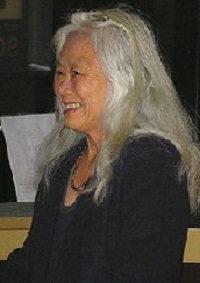 Maxine Hong Kingston
Maxine Hong Kingston
1940-
Maxine Hong Kingston (born October 27, 1940) is a Chinese-American author and Professor Emeritus at the University of California, Berkeley, where she graduated with a B.A. in English in 1962. Kingston has written three novels and several works of nonfiction about the experiences of Chinese immigrants living in the United States. She has contributed to the feminist movement with such works as her memoir, The Woman Warrior, which discusses gender and ethnicity and how these concepts affect the lives of women. Kingston has received several awards for her contributions to Chinese-American Literature, including the National Book Award in 1981 for her novel, China Men.
Kingston was born in Stockton, California, to first-generation Chinese immigrants, Tom and Ying Lan Hong. He was a laundry worker and gambling house owner and she was a practitioner of medicine. Kingston was the third of eight children and the eldest of the six children born in the United States. Her mother trained as a midwife at the To Keung School of Midwifery in Canton. Her father was brought up as a scholar and taught in his village of Sun Woi, near Canton. Tom left China for America in 1924. He was able to bring his wife over in 1939.
Kingston was drawn to writing at a young age and won a $5 prize from Girl Scout Magazine for the essay, “I Am an American.” She majored in engineering at Berkeley before switching to English. In 1962, Kingston married Earl Kingston, an actor, and began a high school teaching career. After relocating to Hawaii in 1967, Maxine began writing extensively, finally completing and publishing her first novel, The Woman Warrior: Memoir of a Girlhood among Ghosts.
Among her works are: The Woman Warrior (1976), awarded the National Book Critics Circle Award for Nonfiction, and China Men (1980), which was awarded the 1981 National Book Award. Another novel, Tripmaster Monkey, is a story depicting a character based on the mythical Chinese character, Sun Wu Kong. Her most recent books are To Be the Poet and The Fifth Book of Peace.
Source: http://en.wikipedia.org/wiki/Maxine_Hong_Kingston
 Bibliography
Bibliography
Press your browser’s BACK button to return to the previous page.
 Galway Kinnell
Galway Kinnell
1927-2014
Galway Kinnell (born February 1, 1927-October 28, 2014) was an American poet. He was Poet Laureate of Vermont from 1989 to 1993. An admitted follower of Walt Whitman, Kinnell rejected the idea of seeking fulfillment by escaping into the imaginary world. His best-loved and most-anthologized poems are “St. Francis and the Sow” and “After Making Love We Hear Footsteps.”
Born in Providence, Rhode Island, Kinnell said that as a youth he was turned on to poetry by Edgar Allan Poe and Emily Dickinson, drawn to both the musical appeal of their poetry and the idea that they led solitary lives. The allure of the language spoke to what he described as the homogeneous feel of his hometown, Pawtucket, Rhode Island. He also described himself as an introvert during his childhood.
Kinnell studied at Princeton University, graduating in 1948 with his friend and fellow poet W.S. Merwin. He received his master of arts degree from the University of Rochester. He traveled extensively in Europe and the Middle East and went to Paris on a Fulbright Fellowship. During the 1960s, the Civil Rights Movement in the United States caught his attention. Upon returning to the U.S., he joined CORE (Congress of Racial Equality) and worked on voter registration and workplace integration in Hammond, Louisiana. This effort got him arrested. In 1968, he signed the “Writers and Editors War Tax Protest” pledge, vowing to refuse tax payments in protest against the Vietnam War. Kinnell drew upon both his involvement with the civil rights movement and his experiences protesting against the Vietnam War in his book-length poem, The Book of Nightmares.
Kinnell was the Erich Maria Remarque Professor of Creative Writing at New York University and a Chancellor of the American Academy of Poets. As of 2011, he retired to his home in Vermont until his death in October 2014 from leukemia.
Source: http://en.wikipedia.org/wiki/Galway_Kinnell
 Bibliography
Bibliography
Press your browser’s BACK button to return to the previous page.
 Rudyard Kipling
Rudyard Kipling
1865-1936
Joseph Rudyard Kipling (December 30, 1865-January 18, 1936) was an English poet, short story writer and novelist chiefly remembered for his celebration of British imperialism, tales and poems of British soldiers in India and his stories for children.
He was born in Bombay, in the Bombay Presidency of British India, and was taken by his family to England when he was five years old.
Kipling is best known for his works of fiction, including: The Jungle Book (a collection of stories that includes “Rikki-Tikki-Tavi”); Just So Stories (1902); Kim (1901); many short stories, including “The Man Who Would Be King” (1888); and his poems, including “Mandalay” (1890), “Gunga Din” (1890), “The White Man’s Burden” (1899) and “If” (1910). He is regarded as a major “innovator in the art of the short story;” his children’s books are enduring classics of children’s literature and his best works are said to exhibit “a versatile and luminous narrative gift.”
Kipling was one of the most popular writers in England, in both prose and verse, in the late 19th and early 20th centuries. In 1907, he was awarded the Nobel Prize in Literature, making him the first English-language writer to receive the prize, and to date he remains its youngest recipient. Among other honors, he was sounded out for the British Poet Laureateship and on several occasions for a knighthood, all of which he declined.
Kipling wrote steadily until the early 1930s, but at a slower pace and with much less success than before. He died of a perforated duodenal ulcer on January 18, 1936 at the age of 70.
Source: http://en.wikipedia.org/wiki/Rudyard_Kipling
 Bibliography
Bibliography
Press your browser’s BACK button to return to the previous page.
 Caroline Kirkland
Caroline Kirkland
1801-1864
Caroline Kirkland (January 12, 1801-April 6, 1864) was born into a middle-class family in New York City, the oldest of 11 children. Her mother was a writer of fiction and poetry. Her father died when she was 21 and the family followed her to upstate New York, where she taught and had met her future husband. The death of her father had made her mainly responsible for the rest of the family. She married William Kirkland in 1828 and they settled in Geneva, New York, where they founded the Domestic School.
In 1835, the Kirklands moved to the then-frontier town of Detroit, Michigan, and in 1837 they founded the village of Pinckney on land that William had purchased. It was there that Caroline had success with her first book, A New Home; Who’ll Follow. She wrote another book about life in the settlements, Forest Life, while still in Michigan. The Kirklands left Michigan in 1843 because their venture to establish the town of Pinckney was not a financial success, and because they felt shut out by the reactions of their neighbors to Kirkland’s frank revelations of frontier life. A third book based on frontier life, Western Clearings, came out in 1845, after she had returned with her family to New York City.
In New York, William Kirkland entered the newspaper business as editor of The New York Evening Mirror, and of his own paper, The Christian Inquirer. In 1846, an unfortunate accident resulted in his death. Caroline Kirkland continued her literary activities until her death in 1864. Their son, Joseph Kirkland, who was born in Geneva, also became a recognized writer.
On returning to New York, Kirkland opened a school for girls and from 1847 to 1849 was editor of The Union Magazine. She also entered into the literary social life of the community, often entertaining writers, publishers and other notables. Her home was the leading literary salon in the country where Edgar Allan Poe, William Cullen Bryant, Elizabeth Drew Stoddard and others frequently assembled. Kirkland went abroad in 1848 and again in 1850. She was received by Charles Dickens and Elizabeth Barrett Browning and Robert Browning. She also became a close friend and correspondent of Harriet Martineau.
Kirkland, as attested by the above names, had considerable fame and accolades from her writings during her lifetime. Poe in particular thought of her as a significant American writer. She was a relatively early American woman writer who appears to have written because she liked to write and only published what she considered to be well written. She wrote for men as well as women but definitely wrote from a female perspective. Her works continue to be studied in relation to style, contributions to American literature and the influence of the female perspective.
Source: http://en.wikipedia.org/wiki/Caroline_Kirkland
 Bibliography
Bibliography
Press your browser’s BACK button to return to the previous page.
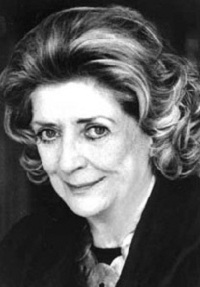 Carolyn Kizer
Carolyn Kizer
1925-2014
Carolyn Ashley Kizer (December 10, 1925-October 9, 2014) was a Pulitzer Prize-winning American poet of the Pacific Northwest whose works reflect her feminism.
Kizer was born in Spokane, Washington, the daughter of a socially prominent Spokane couple. Her father, Benjamin Hamilton Kizer, was 45 when she was born. Her mother, Mabel Ashley Kizer, was a professor of biology who had received her doctorate from Stanford University.
After graduating from Lewis and Clark High School in Spokane, she went on to get her bachelor’s degree from Sarah Lawrence College in 1945 and studied as a graduate at both Columbia University (1945-46) and the University of Washington (1946-47).
She then moved back to Washington state, married Stimson Bullitt, from a wealthy and influential Seattle family, had three children and divorced. In 1954, she enrolled in a creative writing workshop run by poet Theodore Roethke.
In 1959, she helped found Poetry Northwest and served as its editor until 1965.
She then became a “specialist in Literature” for the U.S. State Department in Pakistan from 1965-1966, during which time she taught for several months in that country. In 1966, she became the first director of Literary Programs for the newly created National Endowment for the Arts. She resigned that post in 1970 when the N.E.A. chairman, Roger L. Stevens, was fired by President Richard Nixon. She was a consultant to the N.E.A. for the following year.
In the 1970s and 1980s, she held appointments as poet-in-residence or lecturer at universities across the country, including Columbia, Stanford, Princeton, San Jose State University and the University of North Carolina at Chapel Hill. She was a visiting writer at literary conferences and events across the country, as well as in Dublin, Ireland, and Paris. Kizer was also a member of the faculty of the Iowa Writer’s Workshop.
She was appointed to the post of Chancellor of the Academy of American Poets in 1995, but resigned three years later to protest the absence of women and minorities on the governing board.
Kizer was married to the architect-historian, John Marshall Woodbridge. When she was not teaching and lecturing, she divided her time between their home in Sonoma, California and their apartment in Paris.
She died on October 9, 2014 in Sonoma, California due to effects of dementia.
Source: http://en.wikipedia.org/wiki/Carolyn_Kizer
 Bibliography
Bibliography
Press your browser’s BACK button to return to the previous page.
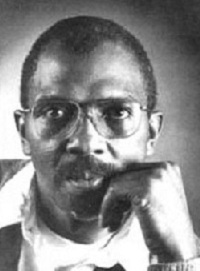 Etheridge Knight
Etheridge Knight
1931-1991
Etheridge Knight was born on April 19, 1931, in Corinth, Mississippi. He was one of seven children in a poor family and only completed a ninth-grade education. Spending many of his adolescent years working in pool halls, bars and juke joints, he mastered the art of “telling toasts.” Toasts are long narrative poems coming from an oral tradition, performed from memory and with spirit. This environment honed his poetic experience, however, it also introduced him to drugs, to which he became addicted an early age.
He joined the U.S. Army, serving as a medical technician in the Korean War. Arrested in Indianapolis for stealing a purse in 1960, Knight was imprisoned for eight years. He recounts this experience in verse in Poems from Prison in 1968 and in prose in the anthology Black Voices from Prison (1970; originally published two years earlier in Italian as Voce negre dal carcere).
After his release from prison, Knight taught at various universities and contributed to several magazines, working for two years as an editor of Motive and as a contributing editor of New Letters (1974). He experimented with rhythmic forms of punctuation in Belly Song and Other Poems (1973), which addressed the themes of ancestry, racism and love. In Born of a Woman (1980), a work that balances personal suffering with affirmation, he introduced the concept of the poet as a “meddler” who forms a trinity with the poem and the reader. Much of his verse was collected in The Essential Etheridge Knight (1986).
Knight’s books and oral performances earned him both popular and critical acclaim. He received honors from such institutions as the Guggenheim Foundation, the National Endowment for the Arts and the Poetry Society of America. In 1990, he earned a bachelor’s degree in American poetry and criminal justice from Martin Center University in Indianapolis.
Etheridge Knight died on March 10, 1991 in Indianapolis, Indiana.
Source: http://www.poemhunter.com/etheridge-knight/biography/
 Bibliography
Bibliography
Press your browser’s BACK button to return to the previous page.
 Sarah Kemble Knight
Sarah Kemble Knight
1666-1727
Sarah Kemble Knight (April 19, 1666-September 25, 1727) was a teacher and businesswoman who is remembered for her diary of a journey from Boston, Massachusetts Bay Colony, to New York City, Province of New York, in 1704-1705, a courageous adventure for a woman to undertake.
She was born in Boston to Thomas Kemble and Elizabeth Trerice. In 1689, she married Richard Knight; they had one child, Elizabeth. Having been left a widow, in middle life she opened a school, which gained some reputation in Boston and included Benjamin Franklin among its students. Before opening this school, Madam Knight, as she was generally called, in 1704 took a journey on horseback from Boston to New York City, an unparalleled feat for a woman. She recounted her experiences in the “journals” that have made her known to students of American Colonial literature and history. The small diary of her Boston-New York journey was first published, posthumously, in 1825, by Theodore Dwight. The Journal of Madam Knight has subsequently been reprinted by others with additional biographical information.
Her journal remains noteworthy both for its larger-than-life central character (Knight) and its telling of a trying journey not normally undertaken by a woman. The discomforts of primitive traveling are described with much sprightliness and not a little humor. Despite its uniqueness, its authenticity has been contested. Dwight stated that, after the publication of his volume, the manuscript was unfortunately burned. Furthermore, much of it had been in shorthand and never translated.
In 1714, Knight’s daughter married John Livingston, of Connecticut, and Madam Knight moved with them to New London, where she continued her business and land dealings. When she died in 1727, she left her daughter a very large estate, attesting to her shrewdness and skill as a businessperson.
Sarah Kemble Knight is buried at Ye Antientist Burial Ground, New London.
Source: http://en.wikipedia.org/wiki/Sarah_Kemble_Knight
 Bibliography
Bibliography
Press your browser’s BACK button to return to the previous page.
 John Knowles
John Knowles
1926-2001
John Knowles (September 16, 1926-November 29, 2001) was an American novelist best known for his novel, A Separate Peace.
Knowles was born in Fairmont, West Virginia, the son of James M. Knowles, a purchasing agent from Lowell, Massachusetts, and Mary Beatrice Shea Knowles from Concord, New Hampshire. In his home town, Knowles’ father was the vice president of a coal company and, fortunately, they received a steady income and were able to live a good life. He attended St. Peter’s High School in Fairmont, West Virginia, from 1940 until 1942, before continuing at Phillips Exeter Academy in Exeter, New Hampshire, graduating in 1945. Knowles graduated from Yale University as a member of the class of 1949.
A Separate Peace was first published in London by Secker and Warburg in 1959. The novel was published in New York in 1960 by Macmillan. Knowles’ other significant works are: Morning in Antibes; Double Vision: American Thoughts Abroad; Indian Summer; The Paragon; and Peace Breaks Out. None of these later works was as well-received as A Separate Peace.
As a resident of Southampton, New York, Knowles wrote seven novels, a book on travel and a collection of stories. He was the winner of the William Faulkner Award and the Rosenthal Award of the National Institute of Arts and Letters. In his later years, Knowles lectured to university audiences.
Knowles died in 2001, at the age of 75, in Fort Lauderdale, Florida.
Source: http://en.wikipedia.org/wiki/John_Knowles
 Bibliography
Bibliography
Press your browser’s BACK button to return to the previous page.
 Kenneth Koch
Kenneth Koch
1925-2002
Kenneth Koch was born in Cincinnati, Ohio, on February 27, 1925. He studied at Harvard University, where he received his Bachelor of Arts degree, and attended Columbia University for his Ph.D. As a young poet, Koch was known for his association with the New York School of poetry.
Koch’s association with the New York School worked, in effect, as an apprenticeship. Many critics found Koch’s early work obscure, such as Poems (1953) and the epic, Ko, or a Season on Earth (1959), yet remarked upon his subsequent writing for its clarity, lyricism and humor, such as in The Art of Love (1975), which was praised as a graceful, humorous book. His other collections of poetry include: New Addresses (2000), winner of the Phi Beta Kappa Poetry Award and a finalist for the National Book Award; Straits (1998); One Train and On the Great Atlantic Rainway, Selected Poems 1950-1988 (both published in 1994), which together earned him the Bollingen Prize in 1995; Seasons of the Earth (1987); On the Edge (1986); Days and Nights (1982); The Burning Mystery of Anna in 1951 (1979); The Duplications (1977); The Pleasures of Peace (1969); When the Sun Tries to Go On (1969); Thank You (1962); and Seasons on Earth (1960).
Koch’s short plays, many of them produced off- and off-off-Broadway, are collected in The Gold Standard: A Book of Plays. He has also published Making Your Own Days: The Pleasures of Reading and Writing Poetry (1998); The Red Robins (1975), a novel; Hotel Lambosa and Other Stories (1993); and several books about teaching children to write poetry, including Wishes, Lies and Dreams and Rose, Where Did You Get That Red? Koch wrote the libretto for composer Marcello Panni’s The Banquet, which premiered in Bremen in June 1998.
His numerous honors include the Rebekah Johnson Bobbitt National Prize for Poetry, awarded by the Library of Congress in 1996, as well as awards from the American Academy of Arts and Letters and the Fulbright, Guggenheim and Ingram-Merrill foundations. In 1996, he was inducted as a member of the American Academy of Arts and Letters. Kenneth Koch lived in New York City, where he was professor of English at Columbia University.
Koch died on July 6, 2002, from leukemia.
Source: http://www.poets.org/poet.php/prmPID/75
 Bibliography
Bibliography
Press your browser’s BACK button to return to the previous page.
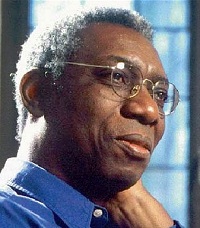 Yusef Komunyakaa
Yusef Komunyakaa
1941-
Yusef Komunyakaa (born April 29, 1941) is an American poet who currently teaches at New York University and is a member of the Fellowship of Southern Writers. Komunyakaa is a recipient of the 1994 Kingsley Tufts Poetry Award for Neon Vernacular, and the 1994 Pulitzer Prize for Poetry. He also received the Ruth Lilly Poetry Prize. Komunyakaa received the 2007 Louisiana Writer Award for his enduring contribution to the poetry world.
His subject matter ranges from the black general experience through rural Southern life before the Civil Rights time period and his experience as a soldier during the Vietnam War.
Komunyakaa was born in 1947 and given the name James William Brown, the eldest of six children of James William Brown, a carpenter. He later reclaimed the name Komunyakaa that his grandfather, a stowaway in a ship from Trinidad, had lost. He grew up in the small town of Bogalusa, Louisiana, before and during the Civil Rights era. He served in the U.S. Army from 1968-1971, serving one tour of duty in South Vietnam during the Vietnam War (1969-1970). He worked as a specialist for the military paper, Southern Cross, covering actions and stories, interviewing fellow soldiers and publishing articles on Vietnamese history, which earned him a Bronze Star.
He began writing poetry in 1973 at the University of Colorado, Colorado Springs Campus, where he was an editor and contributor to the campus arts and literature publication, Riverrun. He earned his M.A. in Writing from Colorado State University in 1978 and an M.F.A. in Creative Writing from the University of California, Irvine, in 1980. In 1985, he became an associate professor at Indiana University, Bloomington. He also held the Ruth Lilly Professorship for two years in 1989-1990.
He taught at Indiana University until the fall of 1997, when he became an English professor at Princeton University. Yusef Komunyakaa is currently a professor in the Creative Writing Program at New York University.
Source: http://en.wikipedia.org/wiki/Yusef_Komunyakaa
 Bibliography
Bibliography
Press your browser’s BACK button to return to the previous page.
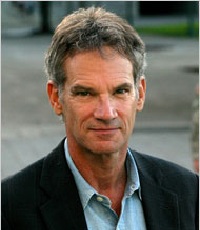 Jon Krakauer
Jon Krakauer
1954-
Jon Krakauer (born April 12, 1954) is an American writer and mountaineer, primarily known for his writing about the outdoors and mountain-climbing. He is the author of bestselling nonfiction books – Into the Wild, Into Thin Air, Under the Banner of Heaven and Where Men Win Glory: The Odyssey of Pat Tillman – as well as numerous magazine articles.
Krakauer was born in Brookline, Massachusetts, as the third of five children and was raised in Corvallis, Oregon, from the age of two. His father introduced the young Krakauer to mountaineering at the age of eight. He competed in tennis at Corvallis High School and graduated in 1972. He went on to study at Hampshire College in Massachusetts, where in 1976 he received his degree in Environmental Studies.
One year after graduating from college (1977), he spent three weeks by himself in the wilderness of the Stikine Icecap region of Alaska and climbed a new route on the Devils Thumb, an experience he described in Eiger Dreams and in Into the Wild.
Much of Krakauer’s popularity as a writer came from being a journalist for Outside magazine. In November 1983, he was able to abandon part-time work as a fisherman and a carpenter to become a full-time writer. His freelance writing involved great variety, in addition to his many works involving mountain climbing. His writing has also appeared in Smithsonian, National Geographic Magazine, Rolling Stone and Architectural Digest.
Into the Wild was published in 1996. The book documents the travels of Christopher McCandless, a young man from a well-to-do East Coast family who, in 1990, after graduating from college, donated all of the money ($24,000) in his bank account to charity, renamed himself “Alexander Supertramp” and began a journey in the American West.
In 1997, he expanded his September 1996 Outside article into his best-known work, Into Thin Air. In 2003, Under the Banner of Heaven became Krakauer’s third nonfiction bestseller.
The book, Where Men Win Glory: The Odyssey of Pat Tillman, was released in 2009. It draws on the journals and letters of Pat Tillman, an NFL professional football player and U.S. Army Ranger whose death in Afghanistan made him a symbol of American sacrifice and heroism.
Source: http://en.wikipedia.org/wiki/Jon_Krakauer
 Bibliography
Bibliography
Press your browser’s BACK button to return to the previous page.
 Stanley Kubrick
Stanley Kubrick
1928-1999
Stanley Kubrick (July 26, 1928-March 7, 1999) was an American film director, screenwriter, producer and cinematographer who lived in England during most of the last four decades of his career.
Several of his films were considered cinematically groundbreaking, including: 2001: A Space Odyssey (1968); Barry Lyndon (1975); and The Shining (1980).
All of Kubrick’s films from the mid-1950s onward, except The Shining, were nominated for Oscars, Golden Globes or BAFTAs. Although he was nominated for an Academy Award as a screenwriter and director on several occasions, his only personal win was for the special effects in 2001: A Space Odyssey.
Some of his films created controversy, including: A Clockwork Orange (1971), as a result of violent scenes; Lolita (1961), with its theme of underage sexuality; and Paths of Glory (1957), banned in France for its anti-war portrayal of French soldiers.
On March 7, 1999, Kubrick died in his sleep from a heart attack at the age of 70.
Source: http://en.wikipedia.org/wiki/Stanley_Kubrick
 Bibliography
Bibliography
Press your browser’s BACK button to return to the previous page.
 Maxine Kumin
Maxine Kumin
1925-2014
Maxine Kumin (born June 6, 1925) was an American poet and author. She was appointed Poet Laureate Consultant in Poetry to the Library of Congress in 1981-1982.
Born in Philadelphia, Maxine Winokur, the daughter of Jewish parents, attended Catholic kindergarten and lower schools. She received her B.A. in 1946 and her M.A. in 1948 from Radcliffe College. In June 1946, she married Victor Kumin, an engineering consultant; they have two daughters and a son. In 1957, she studied poetry with John Holmes at the Boston Center for Adult Education.
Kumin taught English from 1958 to 1961 and 1965 to 1968 at Tufts University; from 1961 to 1963 she was a scholar at the Radcliffe Institute for Independent Study. She has also held appointments as a visiting lecturer and poet in residence at many American colleges and universities. Since 1976, she and her husband have lived on a farm in Warner, New Hampshire, where they breed Arabian and quarter horses.
Kumin’s many awards include: the Eunice Tietjens Memorial Prize for Poetry (1972); the Pulitzer Prize for Poetry (1973) for Up Country; the Aiken Taylor Prize; the 1994 Poets’ Prize; an American Academy and Institute of Arts and Letters Award for excellence in literature (1980); an Academy of American Poets fellowship (1986); the 1999 Ruth Lilly Poetry Prize; and six honorary degrees. In 1981-1982, she served as the poetry consultant to the Library of Congress.
She most recently taught poetry in New England College’s Low-Residency MFA Program. She was also a contributing editor at The Alaska Quarterly Review. Together with fellow-poet Carolyn Kizer, she first served on and then resigned from the board of chancellors of the Academy of American Poets, an act that galvanized the movement for opening this august body to broader representation by women and minorities.
Source: http://en.wikipedia.org/wiki/Maxine_Kumin
 Bibliography
Bibliography
Press your browser’s BACK button to return to the previous page.
 Milan Kundera
Milan Kundera
1929-
Milan Kundera (born April 1, 1929) is a writer of Czech origin who has lived in exile in France since 1975, where he became a naturalized citizen in 1981. He is best known as the author of The Unbearable Lightness of Being, The Book of Laughter and Forgetting and The Joke.
Kundera was born in 1929 at 6 Purkynova Street in Brno, Czechoslovakia, to a middle-class family. His father, Ludvik Kundera (1891-1971), once a pupil of the composer Leos Janacek, was an important Czech musicologist and pianist who served as the head of the Janacek Music Academy in Brno from 1948 to 1961. Kundera learned to play the piano from his father; he later studied musicology and musical composition.
Still in his teens, he joined the Communist Party of Czechoslovakia, which seized power in 1948. He completed his secondary school studies in Brno at Gymnazium trida Kapitana Jarose in 1948. He studied literature and aesthetics at the Faculty of Arts at Charles University in Prague. After two terms, he transferred to the Film Faculty of the Academy of Performing Arts in Prague, where he first attended lectures in film direction and scriptwriting.
After Kundera graduated in 1952, the Film Faculty appointed him a lecturer in world literature. Kundera relinquished his reformist dreams and moved to France in 1975. He taught for a few years in the University of Rennes. He was stripped of Czechoslovak citizenship in 1979; he has been a French citizen since 1981.
Source: http://en.wikipedia.org/wiki/Milan_Kundera
 Bibliography
Bibliography
Press your browser’s BACK button to return to the previous page.
 Stanley Kunitz
Stanley Kunitz
1905-2006
In 1905, Stanley Kunitz was born in Worcester, Massachusetts. He attended Harvard College, where he received a bachelor’s degree in 1926 and a master’s degree in 1927. He served in the U.S. Army in World War II, after a request for conscientious objector status was denied. Following the war, he began teaching, first at Bennington College in Vermont, and later at universities including Columbia, Yale, Princeton, Rutgers and the University of Washington.
Kunitz published his first book of poetry, Intellectual Things, in 1930. Fourteen years later, he published his second book, Passport to War. His recent books include: The Collected Poems of Stanley Kunitz (2000); Passing Through: The Later Poems, New and Selected (1995), which won the National Book Award; Next-to-Last Things: New Poems and Essays (1985); The Poems of Stanley Kunitz, 1928-1978, which won the Lenore Marshall Poetry Prize; The Testing-Tree (1971); and Selected Poems, 1928-1958, which won the Pulitzer Prize.
In 2005, he collaborated with Genine Lentine on The Wild Braid: A Poet Reflects on a Century in the Garden, in which his thoughts on his two great passions, poetry and gardening, are illustrated with photos of the legendary garden at his seaside Provincetown home. Kunitz also co-translated Orchard Lamps by Ivan Drach (1978), Story under Full Sail by Andrei Voznesensky (1974) and Poems of Akhmatova (1973). He edited The Essential Blake (1987), Poems of John Keats (1964) and The Yale Series of Younger Poets (1969-77).
His honors include the Bollingen Prize, a Ford Foundation grant, a Guggenheim Foundation fellowship, Harvard’s Centennial Medal, the Levinson Prize, the Harriet Monroe Poetry Award, a senior fellowship from the National Endowment for the Arts, the National Medal of the Arts and the Shelley Memorial Award. He served for two years as Consultant in Poetry to the Library of Congress, was designated State Poet of New York and a Chancellor Emeritus of The Academy of American Poets. In 2000, he was named United States Poet Laureate.
He died at the age of 100 on May 14, 2006.
Source: http://www.poets.org/poet.php/prmPID/2
 Bibliography
Bibliography
Press your browser’s BACK button to return to the previous page.
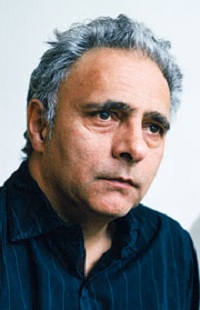 Hanif Kureishi
Hanif Kureishi
1954-
Hanif Kureishi (born December 5, 1954) is an English playwright, screenwriter, filmmaker, novelist and short story writer.
Kureishi was born in Kent to a Pakistani father and an English mother (Audrey Buss). His father, Rafiushan, was from a wealthy Madras family, most of whose members moved to Pakistan after the Partition of British India in 1947. After his parents married, the family settled in Bromley, where Kureishi was born.
He attended Bromley Technical High School and studied for A levels at Bromley College of Technology. He went on to spend a year studying philosophy at Lancaster University before dropping out. Later, he attended King’s College London and took a degree in philosophy.
Kureishi started his career in the ’70s as a pornography writer, under the pseudonyms Antonia French and Karim. He wrote My Beautiful Laundrette in 1985, a screenplay about a gay Pakistani-British boy growing up in 1980s.
His book, The Buddha of Suburbia (1990), won the Whitbread Award for the best first novel. The next year, 1991, saw the release of the feature film, London Kills Me, which he wrote and directed.
His novel, Intimacy (1998), revolved around the story of a man leaving his wife and two young sons after feeling physically and emotionally rejected by his wife. Kureishi’s drama, The Mother, was adapted to a movie. His 2006 screenplay, Venus, earned Oscar, BAFTA, Screen Actors Guild, Broadcast Film Critics Association and Golden Globe nominations. His latest novel, Something to Tell You, was published in 2008. His 1989 novel, The Black Album, adapted for the theatre, was performed at the National Theatre in July and August 2009.
In 2009, he donated the short story, “Long Ago Yesterday,” to Oxfam’s Ox-Tales project, four collections of UK stories written by 38 authors. His story was published in the Earth collection.
Source: http://en.wikipedia.org/wiki/Hanif_Kureishi
 Bibliography
Bibliography
Press your browser’s BACK button to return to the previous page.
 Akira Kurosawa
Akira Kurosawa
1910-1998
Akira Kurosawa (March 23, 1910-September 6, 1998) was a Japanese film director, producer, screenwriter and editor. Regarded as one of the most important and influential filmmakers in the history of cinema, Kurosawa directed 30 films in a career spanning 57 years.
Kurosawa entered the Japanese film industry in 1936, following a brief stint as a painter. After years of working on numerous films as an assistant director and scriptwriter, he made his debut as a director in 1943, during World War II, with the popular action film, Sanshiro Sugata (Judo Saga). After the war, the critically acclaimed Drunken Angel (1948), in which Kurosawa cast then-unknown actor Toshiro Mifune in a starring role, cemented the director’s reputation as one of the most important young filmmakers in Japan. The two men would go on to collaborate on another 15 films.
Rashomon, which premiered in Tokyo in August 1950, became the surprise winner of the Golden Lion at the Venice Film Festival and was subsequently released in Europe and North America. Throughout the 1950s and early 1960s, Kurosawa directed approximately a film a year, including a number of highly regarded films, such as Ikiru (1952), Seven Samurai (1954) and Yojimbo (1961). After the mid-1960s, he became much less prolific, but his later work – including his final two epics, Kagemusha (1980) and Ran (1985) – continued to win awards, including the Palme d’Or for Kagemusha, though more often abroad than in Japan.
In 1990, he accepted the Academy Award for Lifetime Achievement.
On September 6, 1998, Kurosawa died of a stroke in Setagaya, Tokyo, at the age of 88.
Source: http://en.wikipedia.org/wiki/Akira_Kurosawa
 Bibliography
Bibliography
Press your browser’s BACK button to return to the previous page.
 Tony Kushner
Tony Kushner
1956-
Anthony Robert “Tony” Kushner (born July 16, 1956) is an American playwright and screenwriter. He received the Pulitzer Prize for Drama in 1993 for his play, Angels in America: A Gay Fantasia on National Themes, and co-authored with Eric Roth the screenplay for the 2005 film, Munich.
Kushner was born in Manhattan, New York, to Jewish clarinetist and conductor William Kushner and bassoonist Sylvia Deutscher. Shortly after his birth, the family moved to Lake Charles, Louisiana, the seat of Calcasieu Parish, where he spent his childhood.
Kushner moved to New York in 1974 to begin his undergraduate college education at Columbia University, where he received a Bachelor of Arts degree in Medieval Studies in 1978. He attended New York University’s Graduate Acting Program at the Tisch School of the Arts, graduating in 1984.
Kushner received an honorary doctorate in May 2011 from CUNY’s John Jay College of Criminal Justice. In 2008, he also received an honorary degree of Doctor of Letters from SUNY Purchase College.
Kushner’s best-known work is Angels in America (a play in two parts: Millennium Approaches and Perestroika), a seven-hour epic about the AIDS epidemic in Reagan-era New York, which was later adapted into a miniseries for which Kushner wrote the screenplay. His other plays include: Hydriotaphia; Slavs!: Thinking about the Longstanding Problems of Virtue and Happiness; A Bright Room Called Day; Homebody/Kabul; and the book for the musical Caroline, or Change.
His newest completed work, the play The Intelligent Homosexual’s Guide to Capitalism and Socialism with a Key to the Scriptures, began as a novel more than a decade ago.
Source: http://en.wikipedia.org/wiki/Tony_Kushner
 Bibliography
Bibliography
Press your browser’s BACK button to return to the previous page.
 Thomas Kyd
Thomas Kyd
1558-1594
Thomas Kyd (baptized November 6, 1558-buried August 15, 1594) was an English dramatist, the author of The Spanish Tragedy and one of the most important figures in the development of Elizabethan drama.
Thomas Kyd was the son of Francis and Anna Kyd and was baptized in the church of St. Mary Woolnoth in the Ward of Langborn, Lombard Street, London on November 6, 1558. In October 1565, the young Kyd was enrolled in the newly founded Merchant Taylors’ School. Apart from Latin and Greek, the curriculum included music, drama, physical education and “good manners.” There is no evidence that Kyd went on to either of the English universities. He may have followed for a time his father’s profession; two letters written by him are extant and his handwriting suggests the training of a scrivener.
Evidence suggests that in the 1580s Kyd became an important playwright, but little is known about his activity. Francis Meres placed him among “our best for tragedy” and Heywood elsewhere called him “Famous Kyd.” Ben Jonson mentions him in the same breath as Christopher Marlowe and John Lyly in the Shakespeare First Folio.
The Spanish Tragedie was probably written in the mid- to late-1580s. The earliest surviving edition was printed in 1592; the play was usually known simply as Hieronimo, after the protagonist. It was arguably the most popular play of the “Age of Shakespeare” and set new standards in effective plot construction and character development.
Other works by Kyd are: his translations of Torquato Tasso’s Padre di Famiglia, published as The Householder’s Philosophy (1588); and Robert Garnier’s Cornelia (1594). Plays attributed in whole or in part to Kyd include: Soliman and Perseda; King Leir; Arden of Feversham; and Edward III. Kyd is more generally accepted to have been the author of Ur-Hamlet, the precursor of the Shakespearean play. Some poems by Kyd exist, but it seems that most of his work is lost or unidentified. He is also the presumed author of a pamphlet in prose, The Murder of John Brewen (1592), a grisly report on murder in a family, in which a goldsmith is killed by his wife.
From 1587 to 1593, Kyd was in the service of an unidentified noble. He may have worked as a secretary, if he did not also write plays. Around 1591, Christopher Marlowe also joined this patron’s service and, for a while, Marlowe and Kyd shared lodgings and perhaps even ideas.
On May 11, 1593, the Privy Council ordered the arrest of the authors of “divers lewd and mutinous libels” that had been posted around London. The next day, Kyd was among those arrested; he would later believe that he had been the victim of an informer. Kyd was eventually released but was not accepted back into his patron’s service.
The last we hear from the playwright is the publication of Cornelia early in 1594. Kyd died later that year and was buried on August 15, in London. He was only 35.
Source: http://en.wikipedia.org/wiki/Thomas_Kyd
 Bibliography
Bibliography